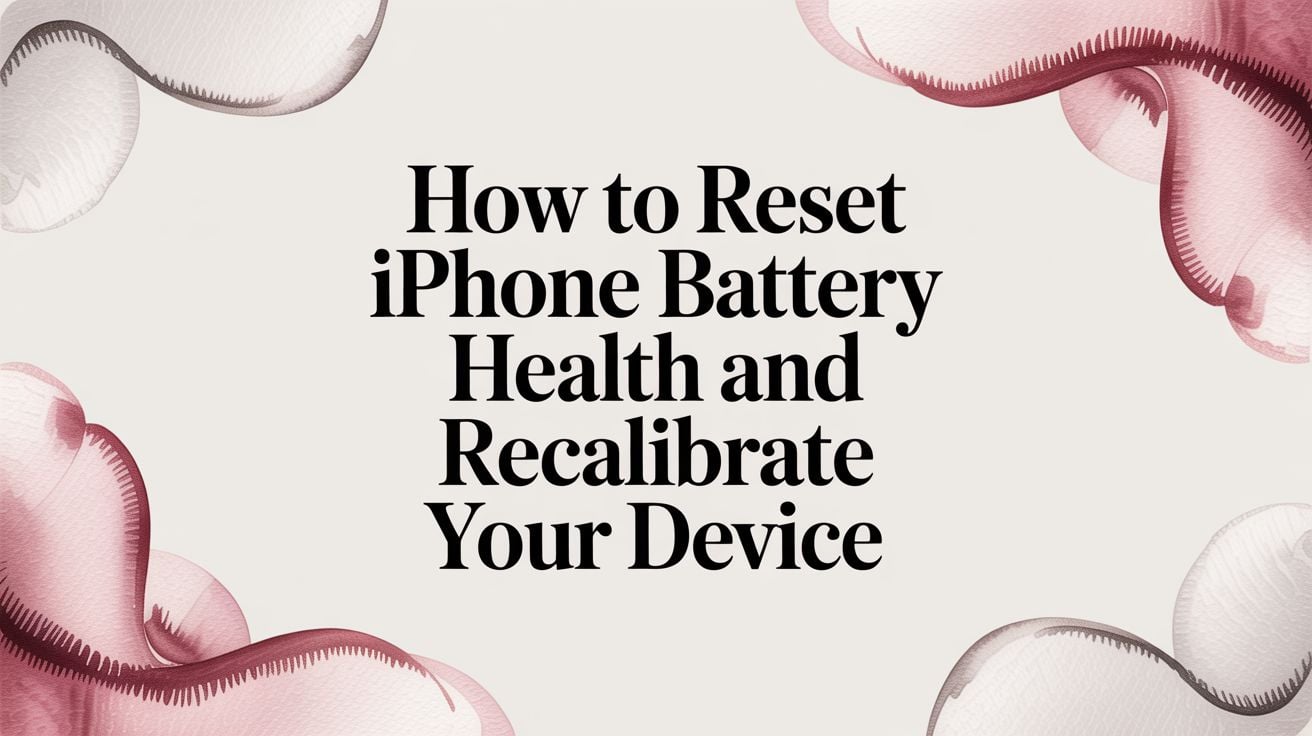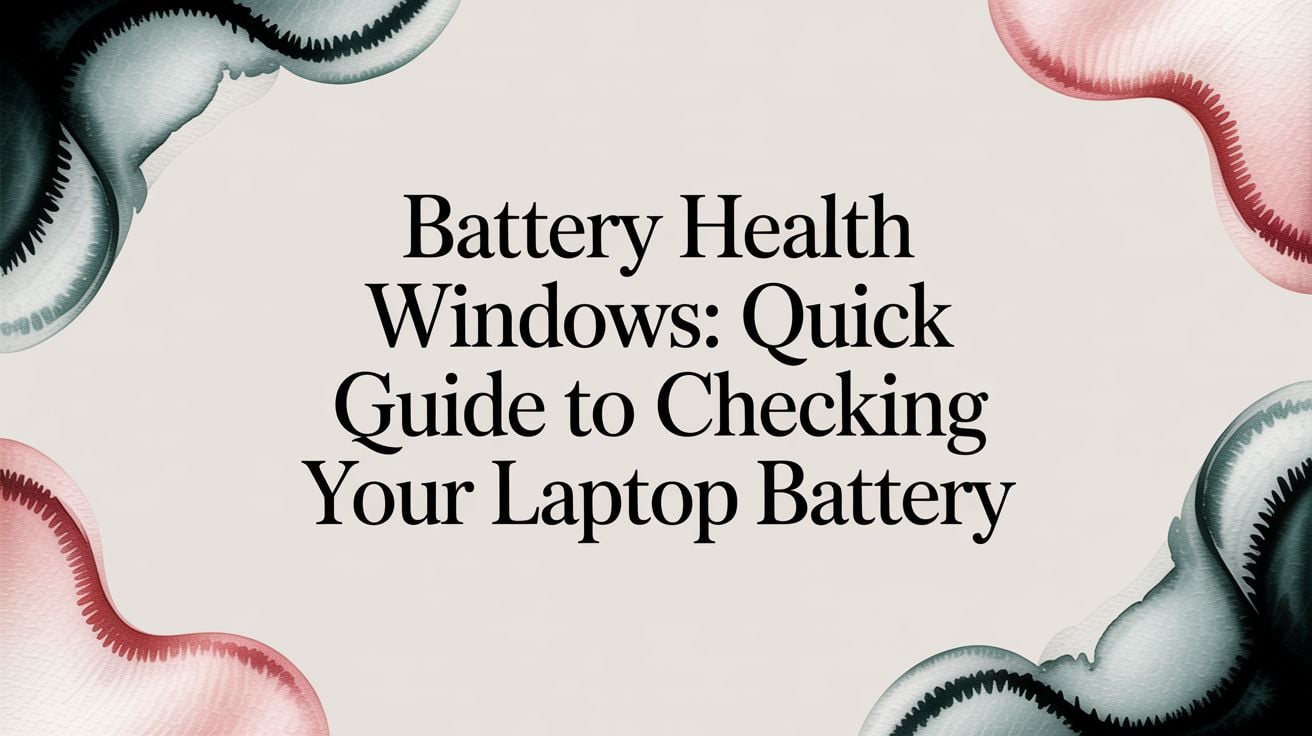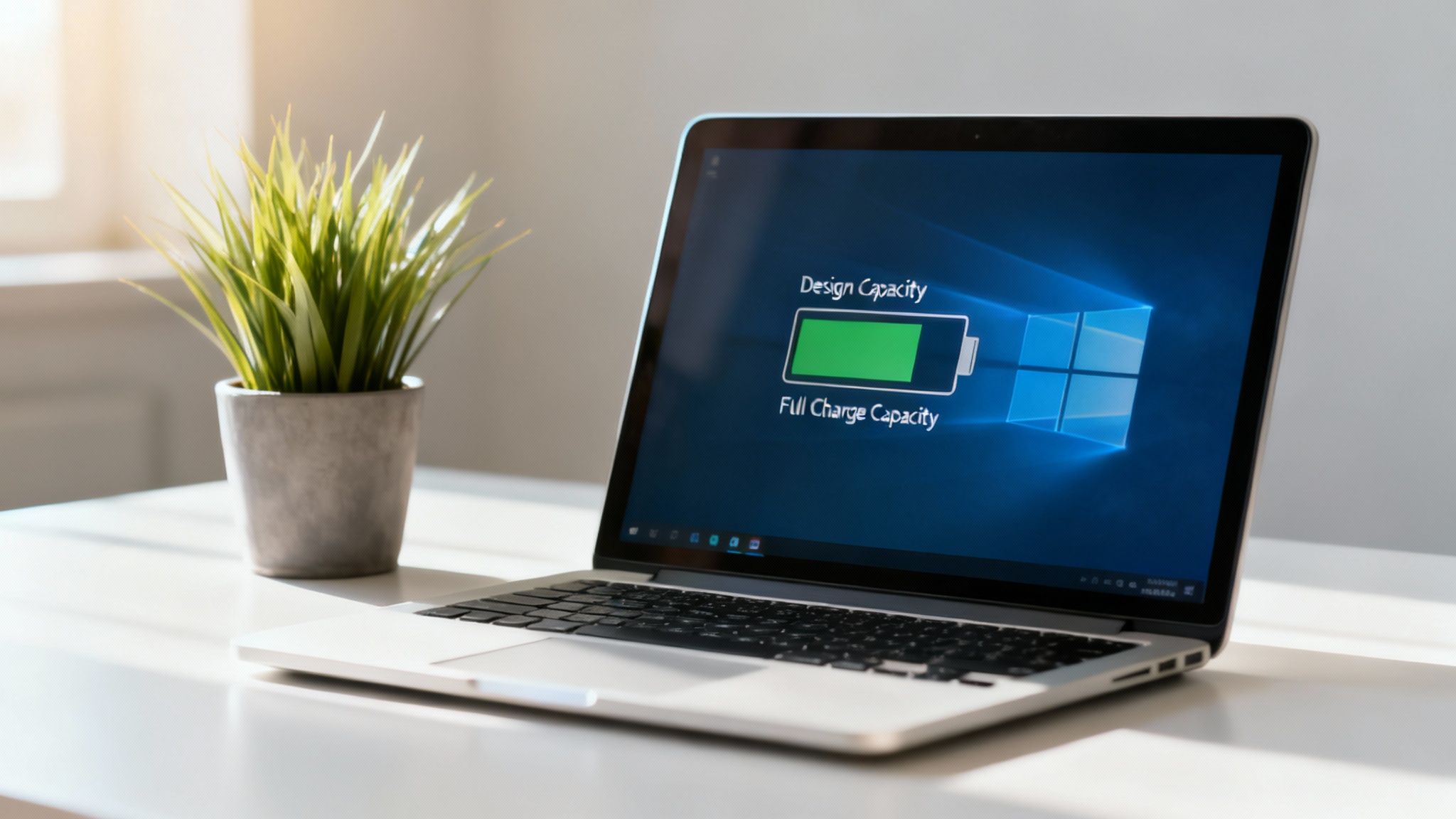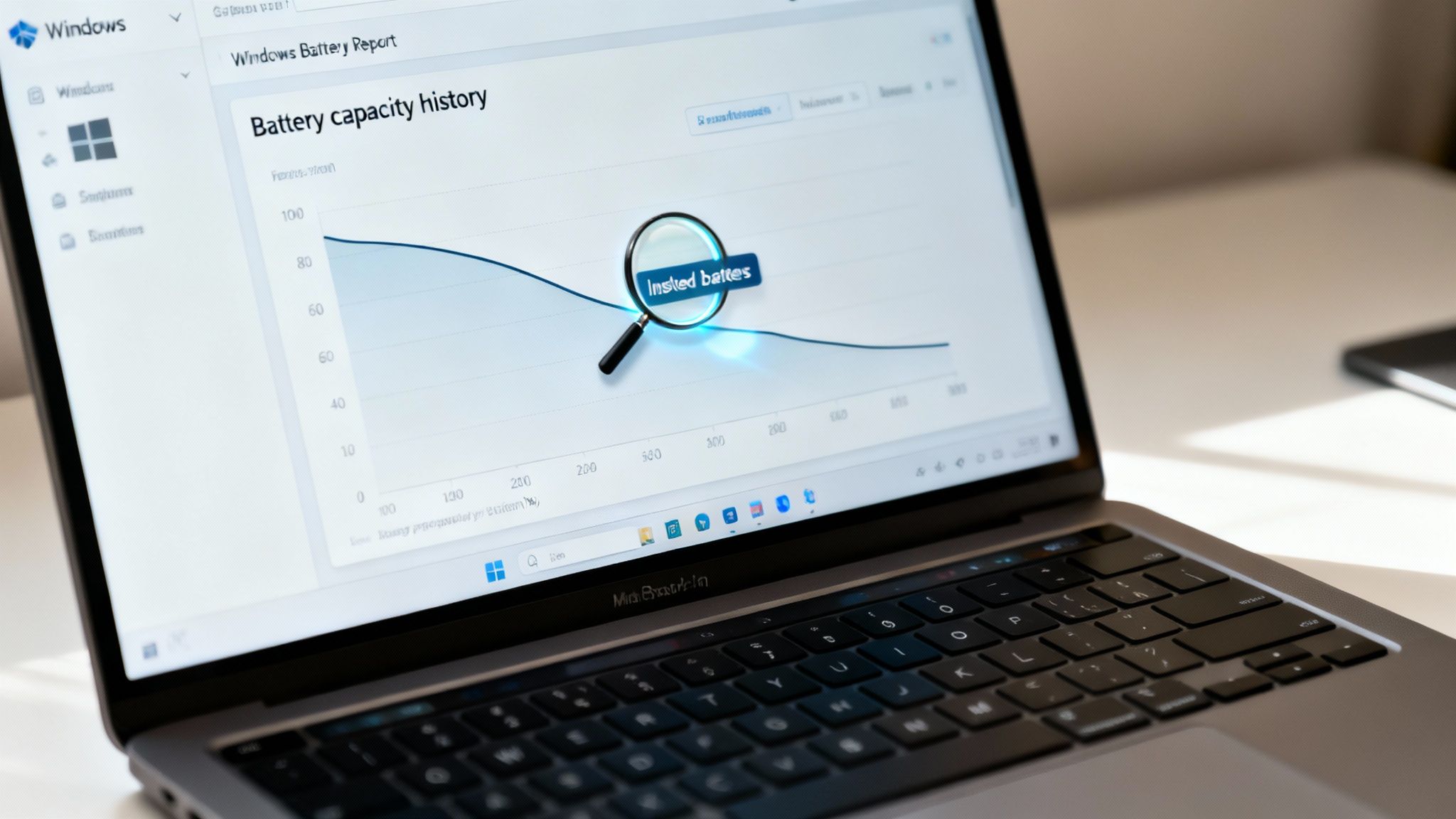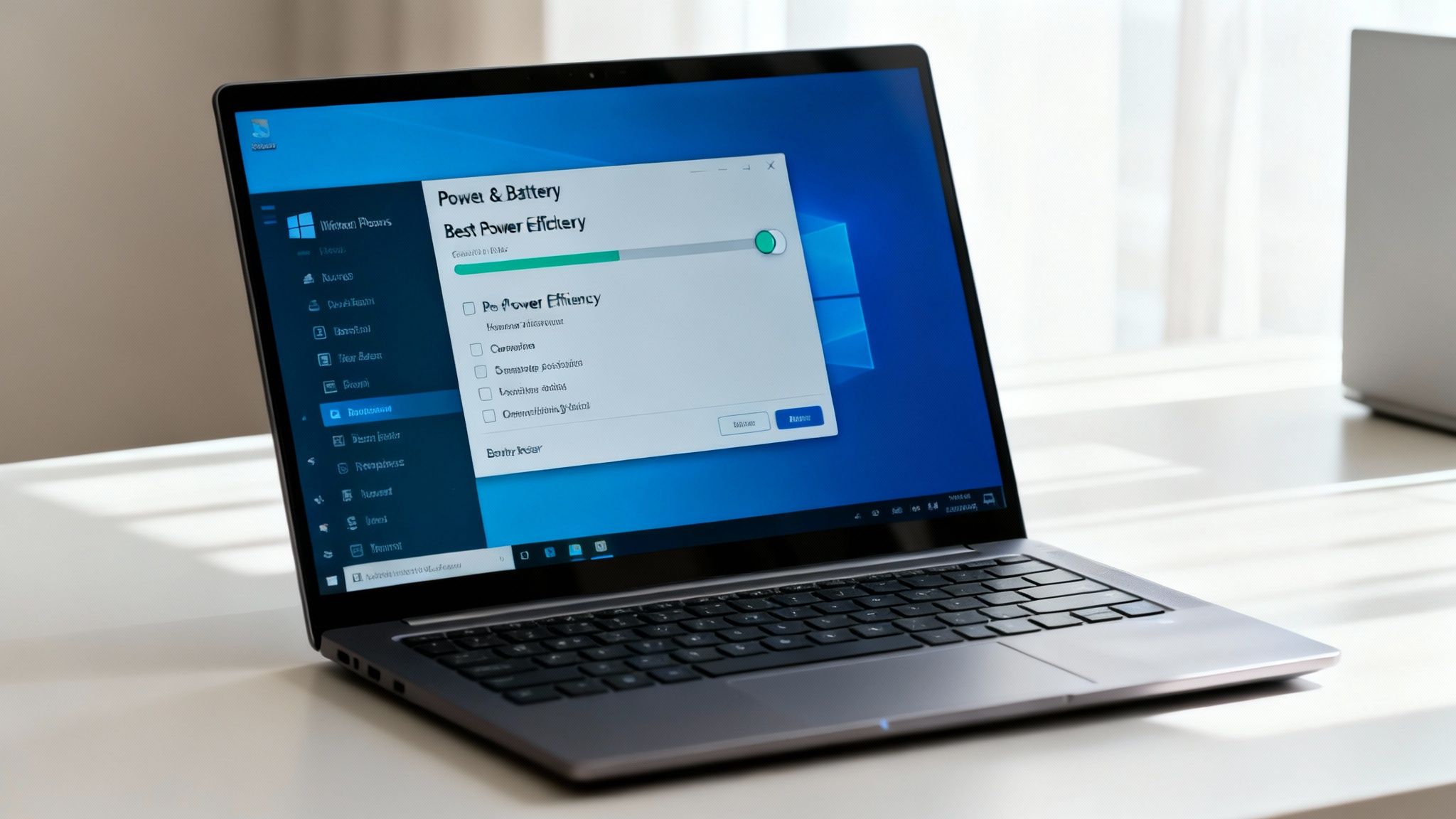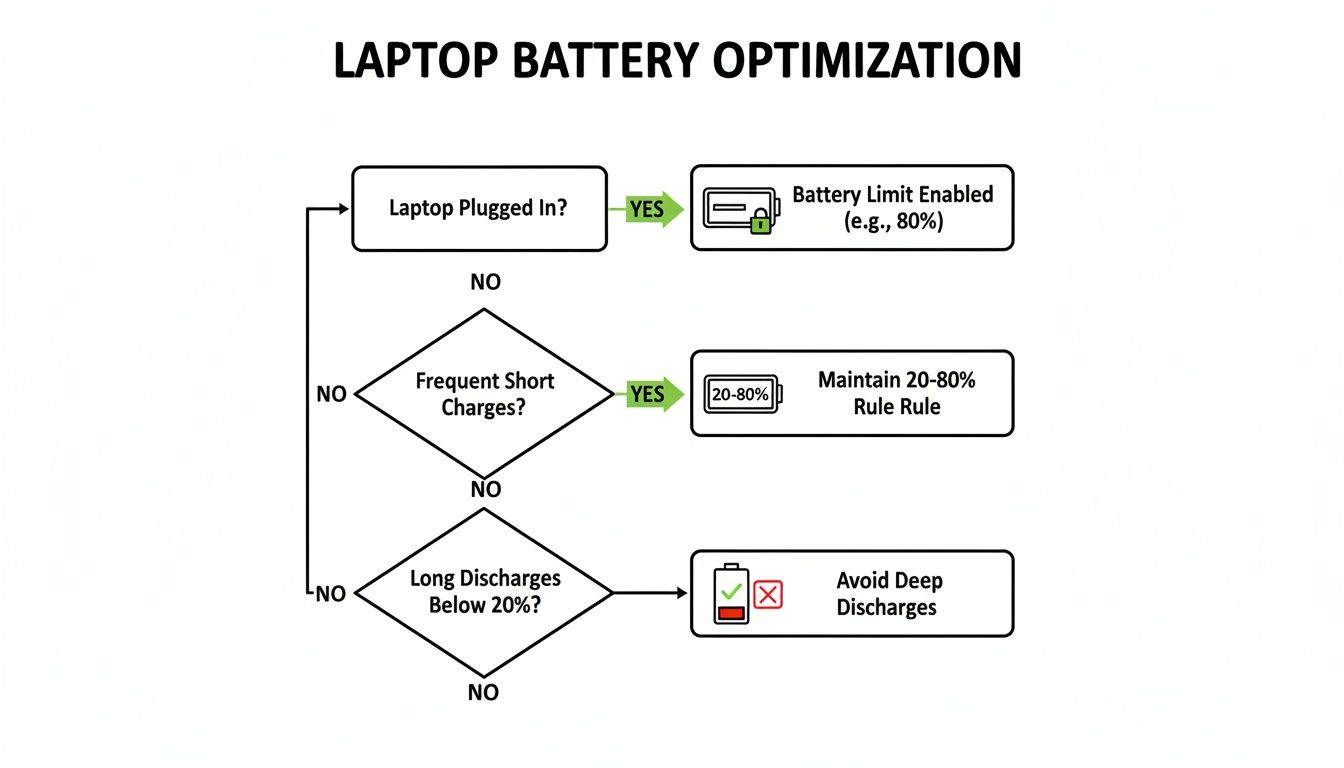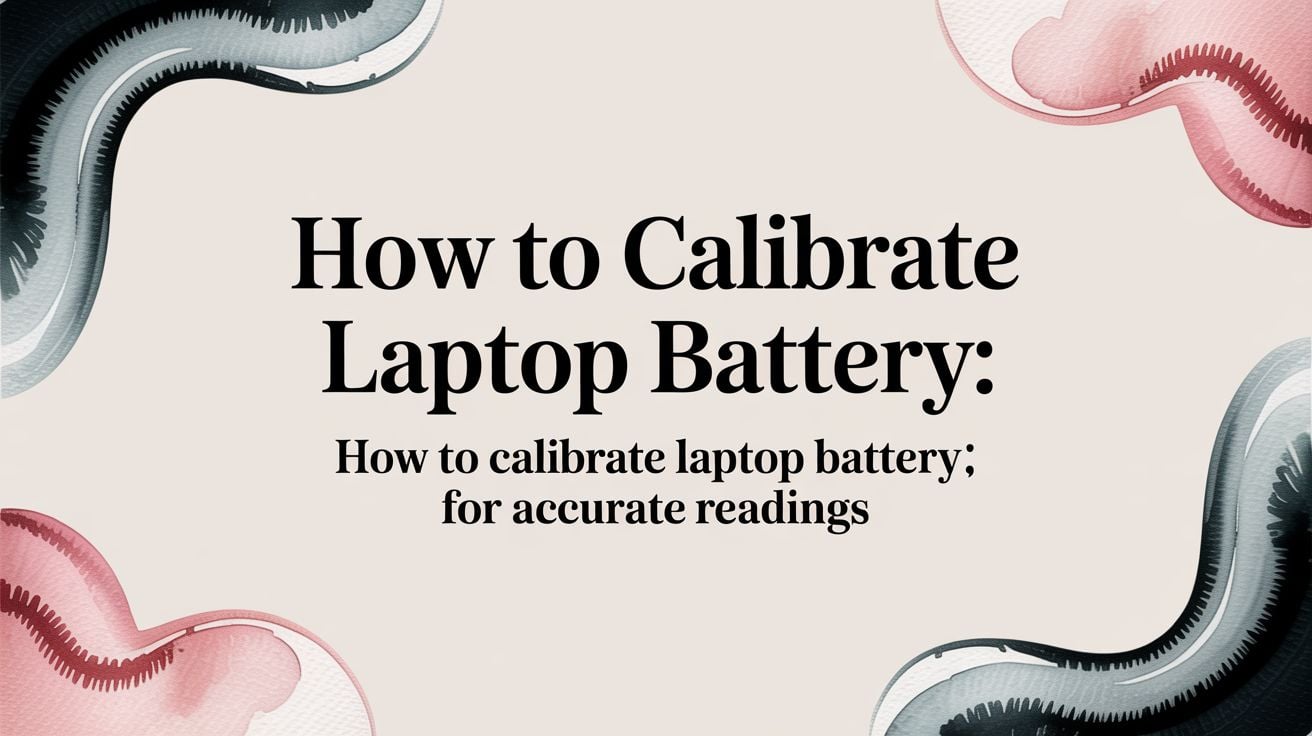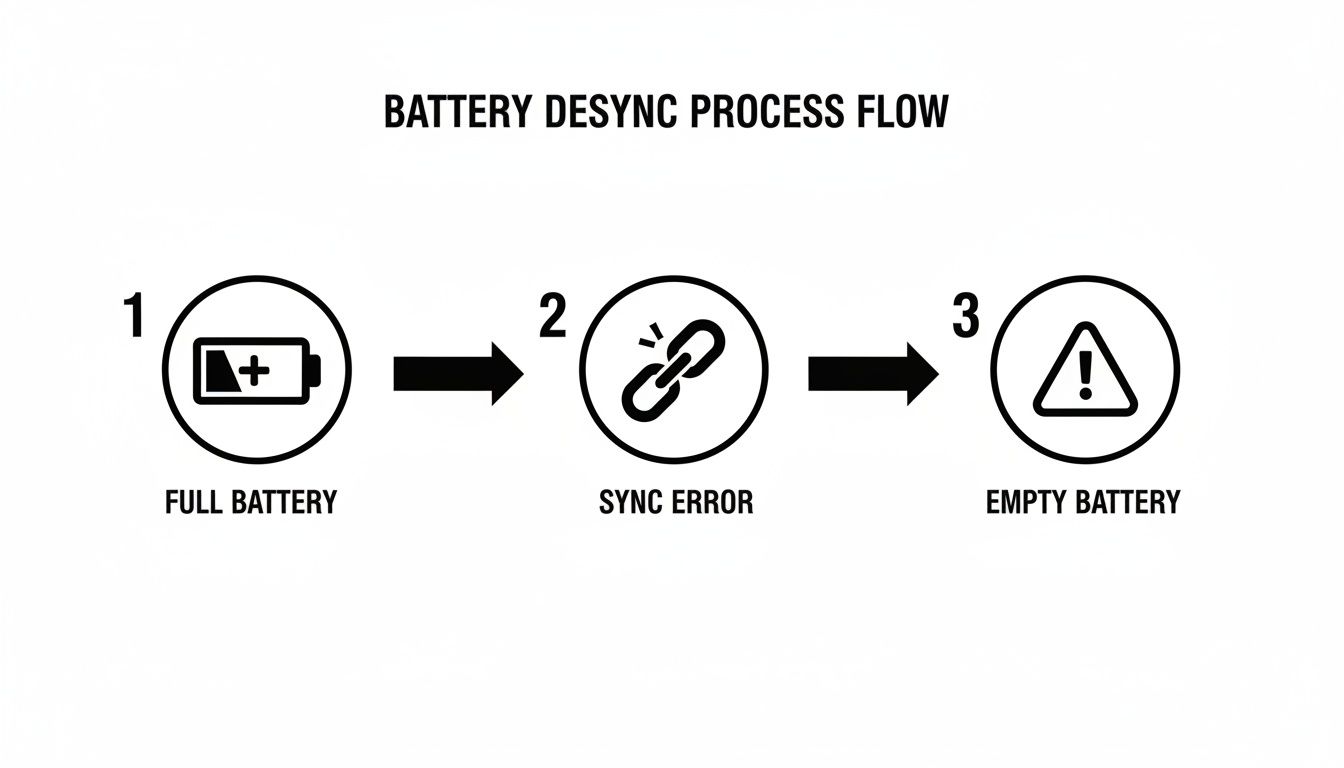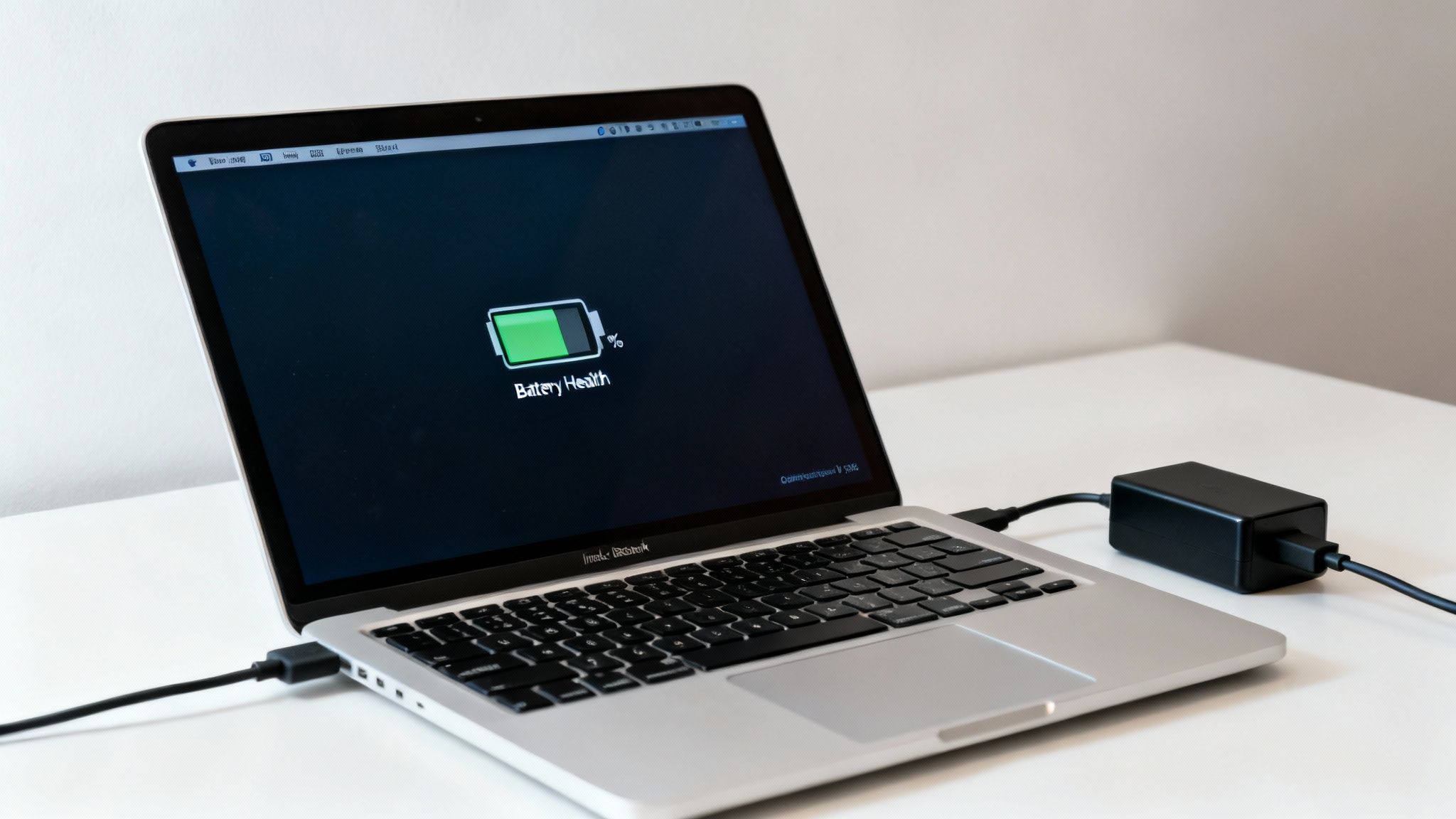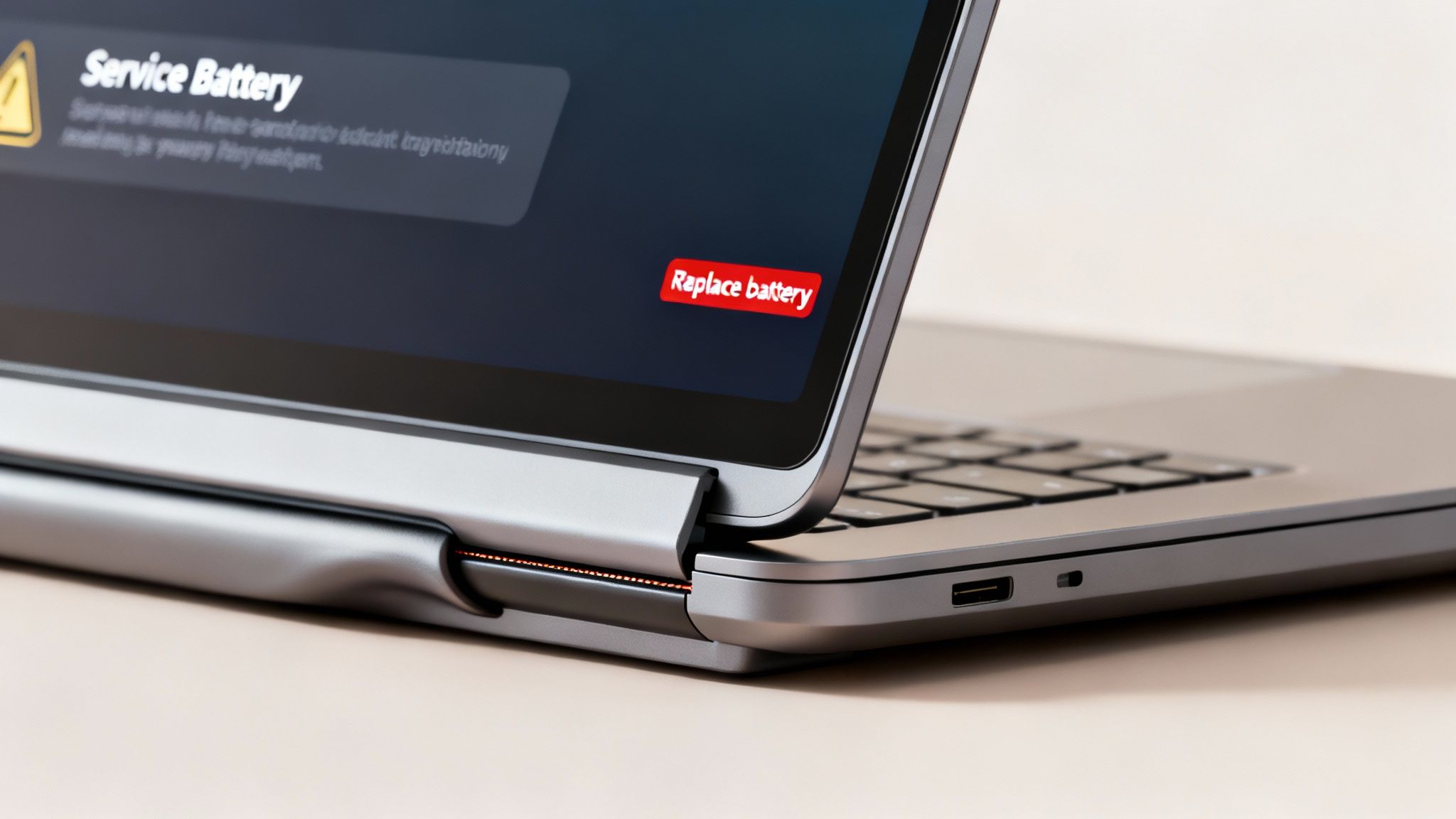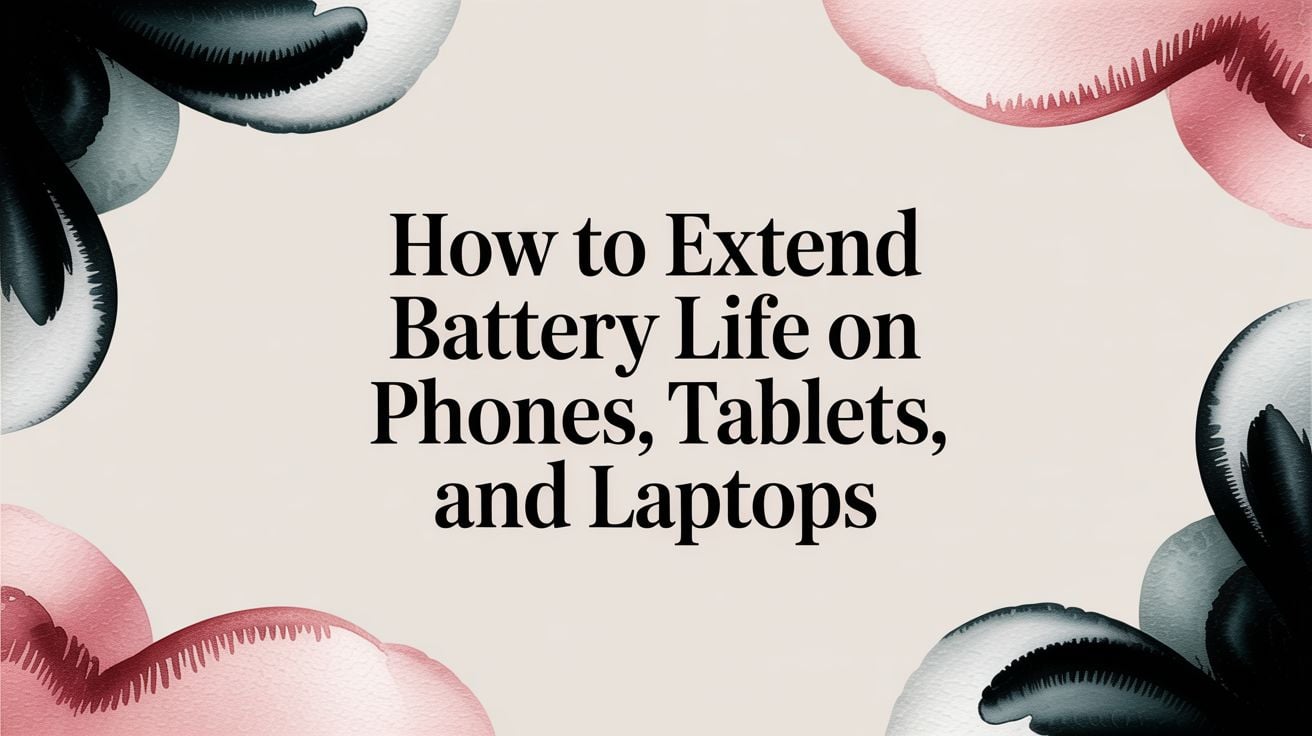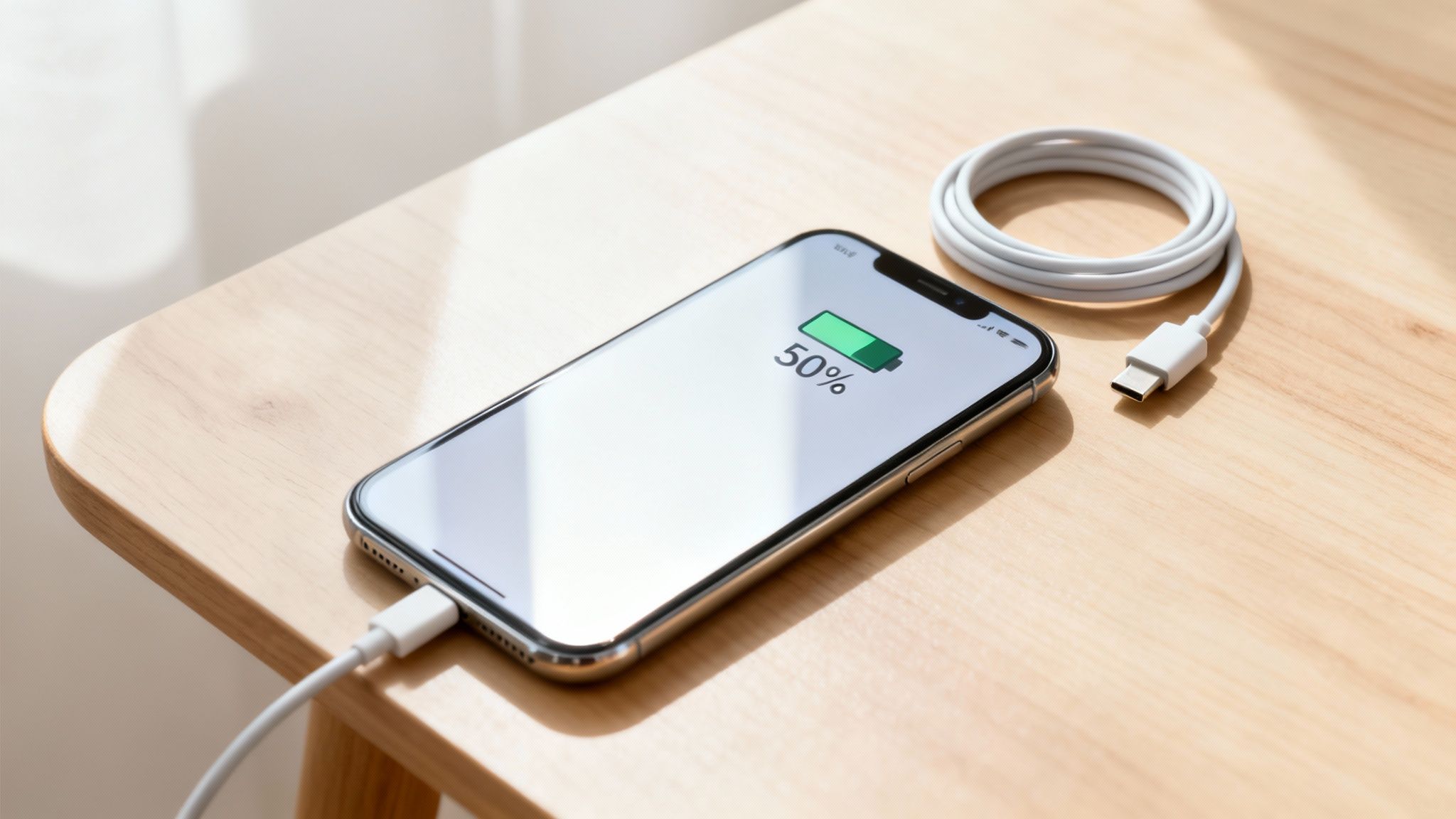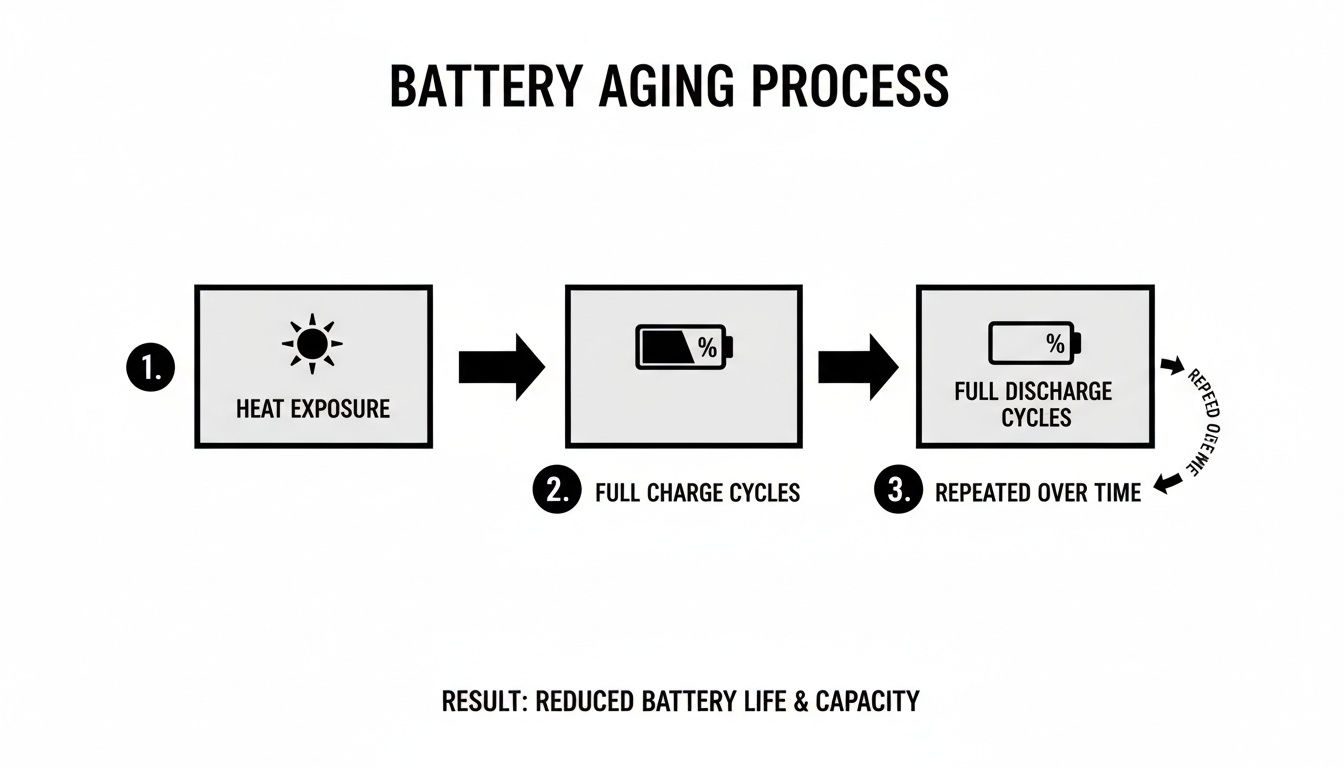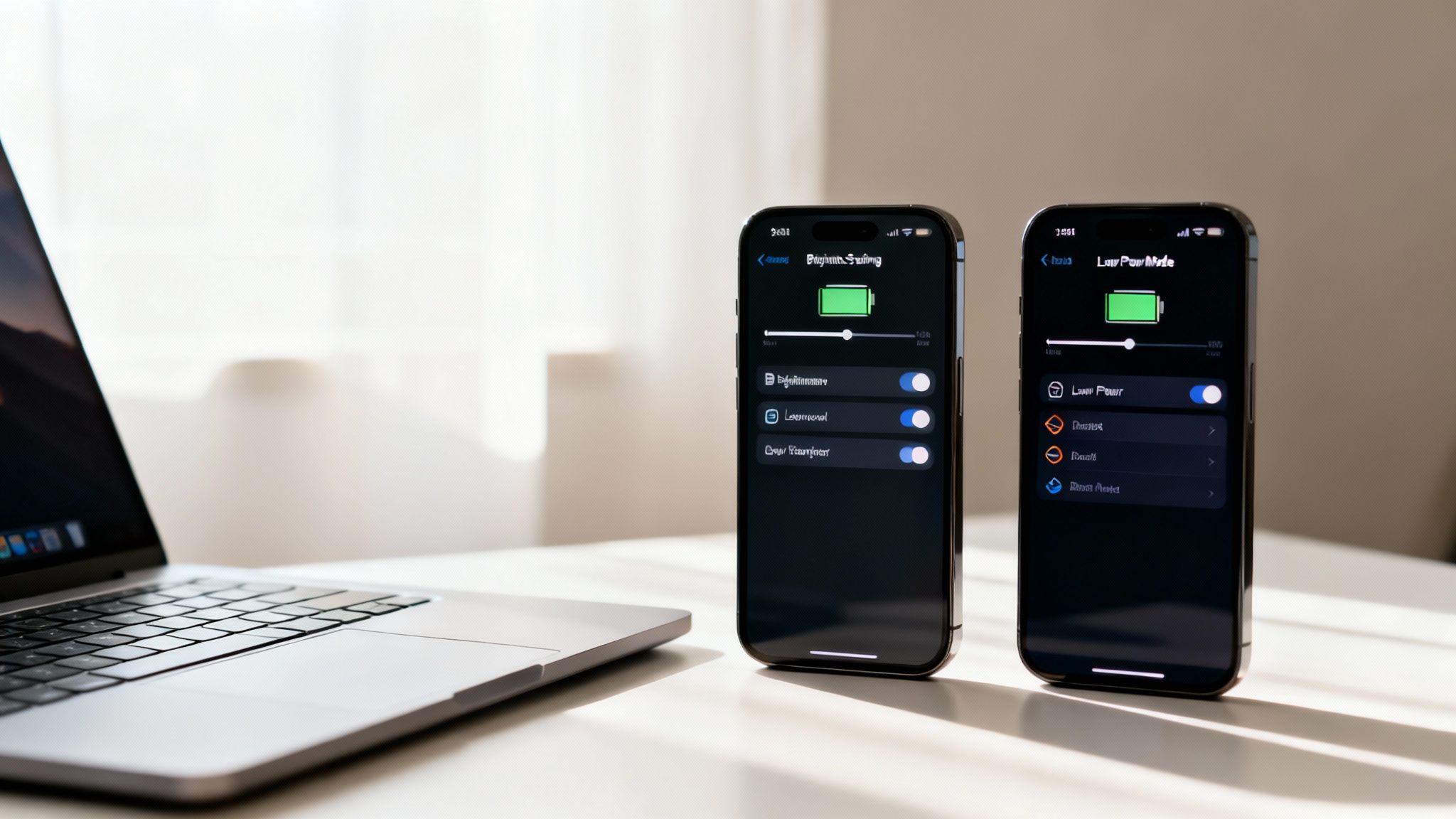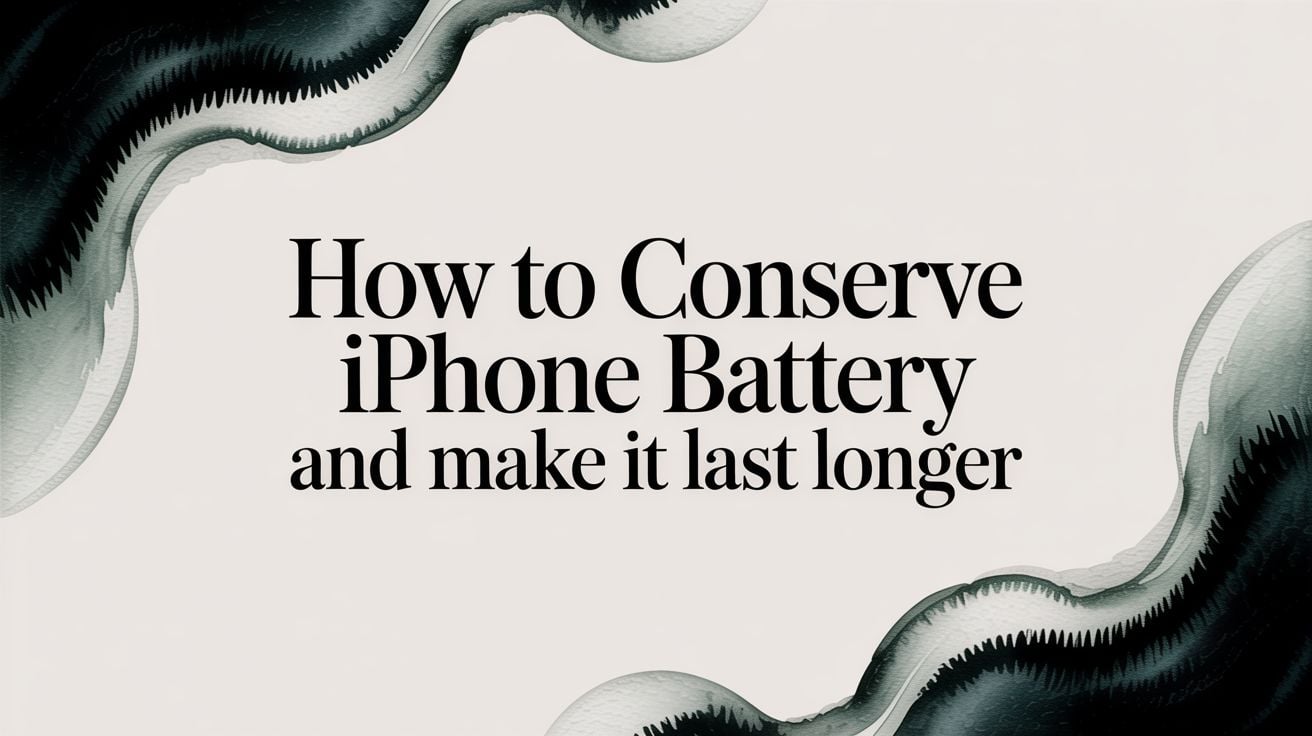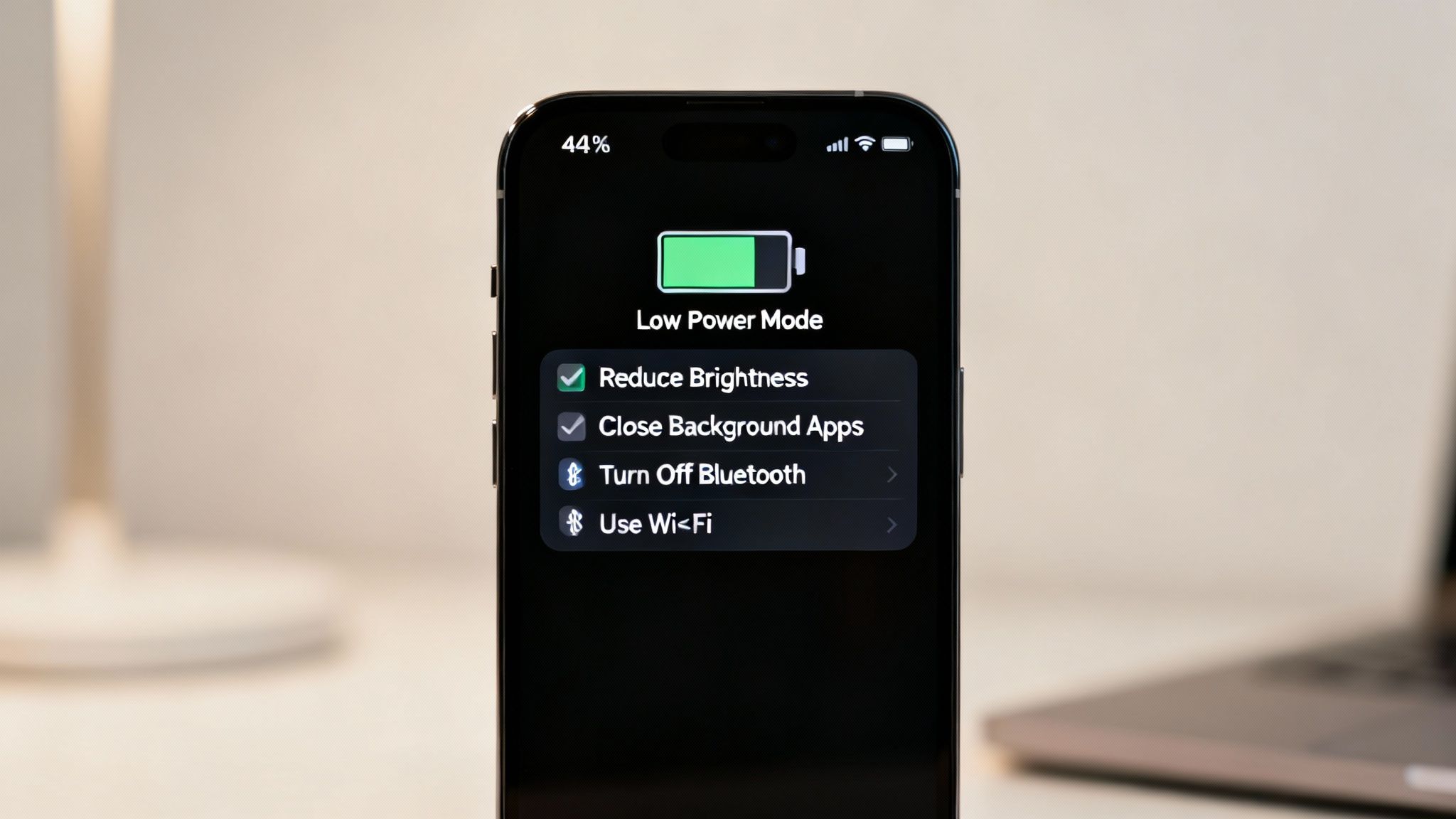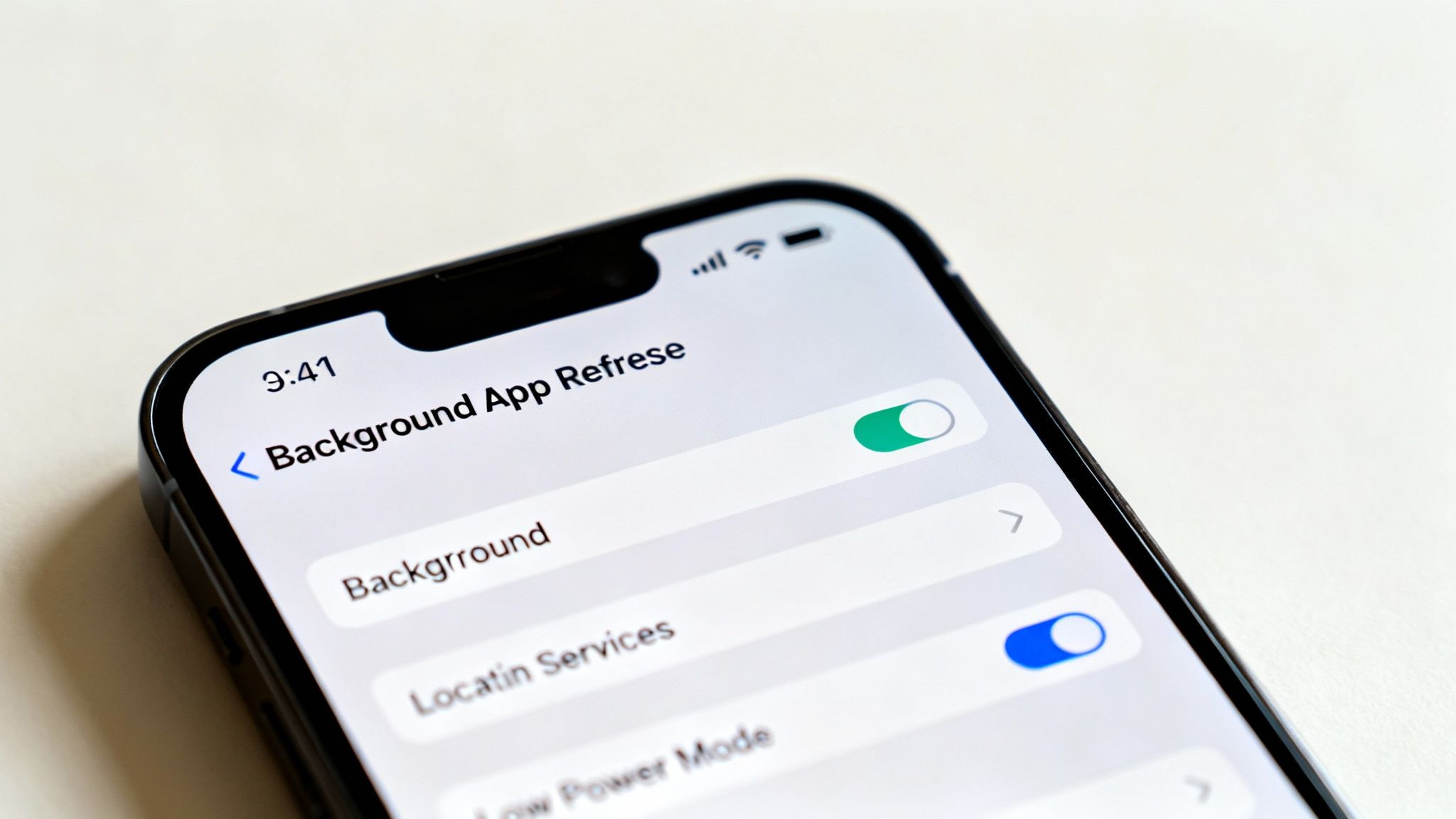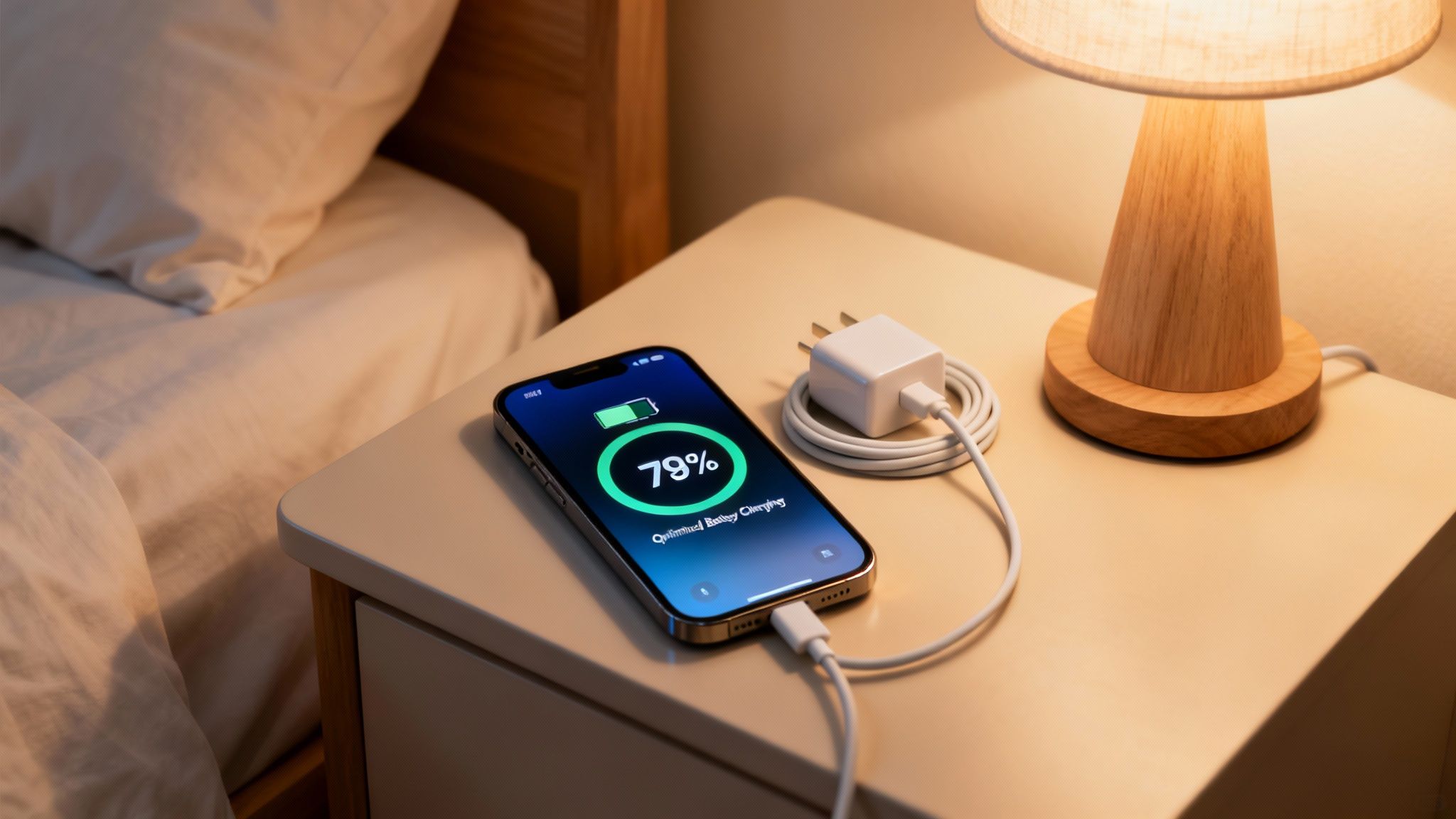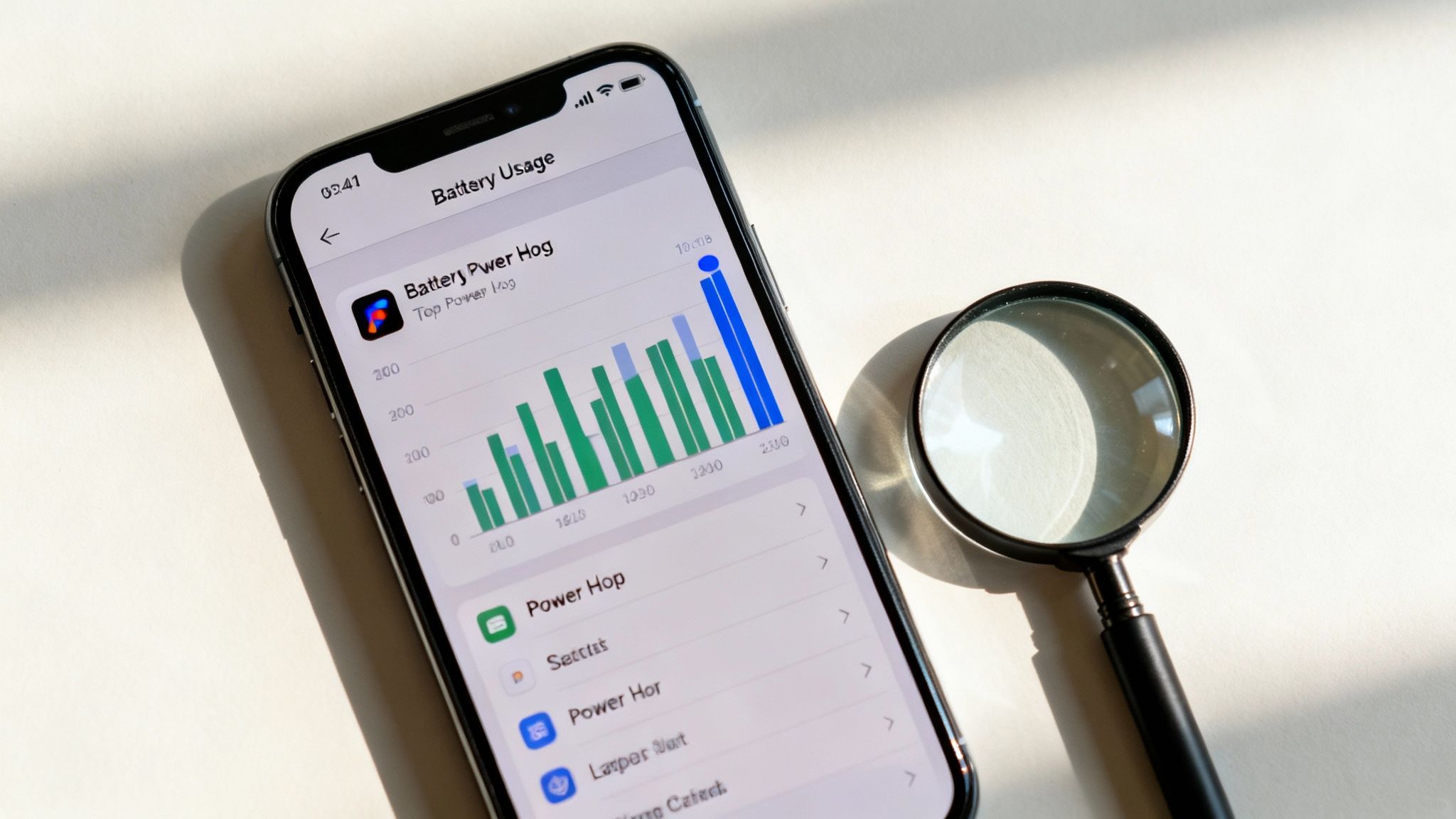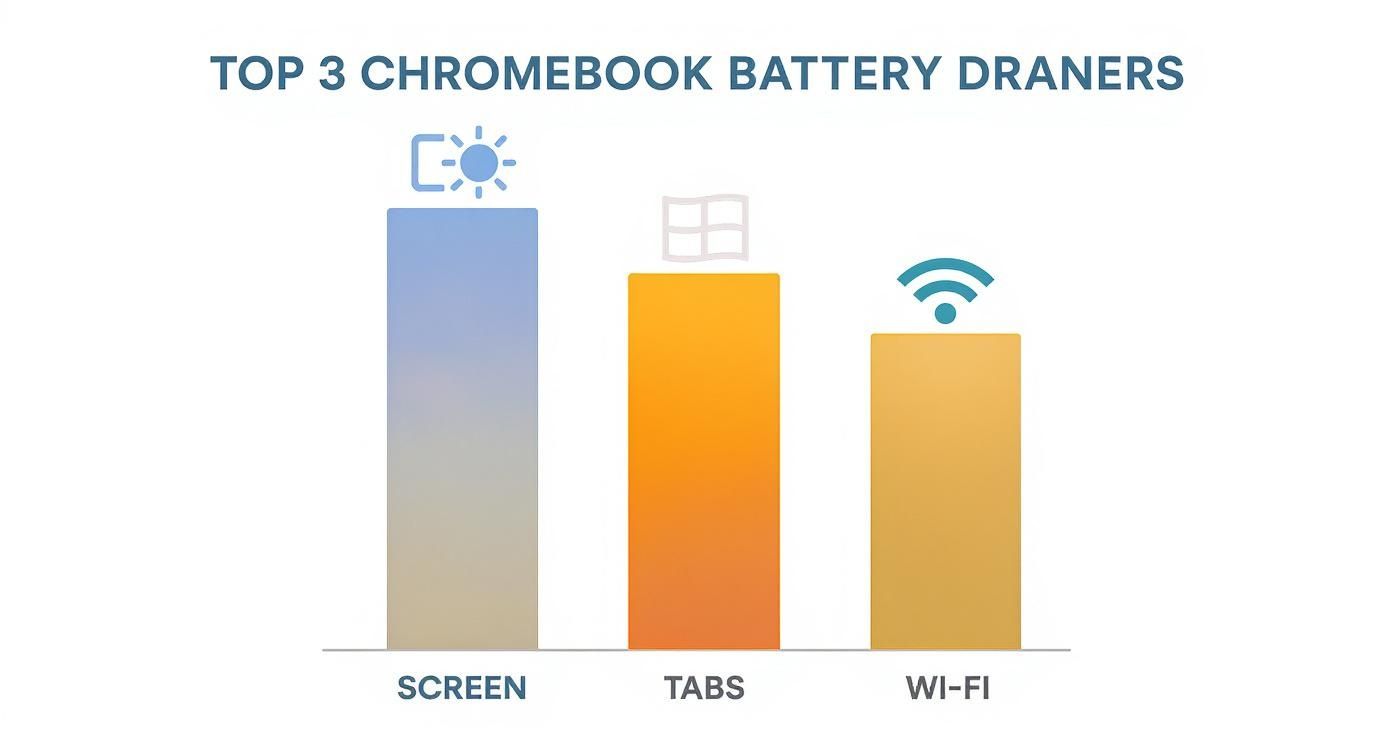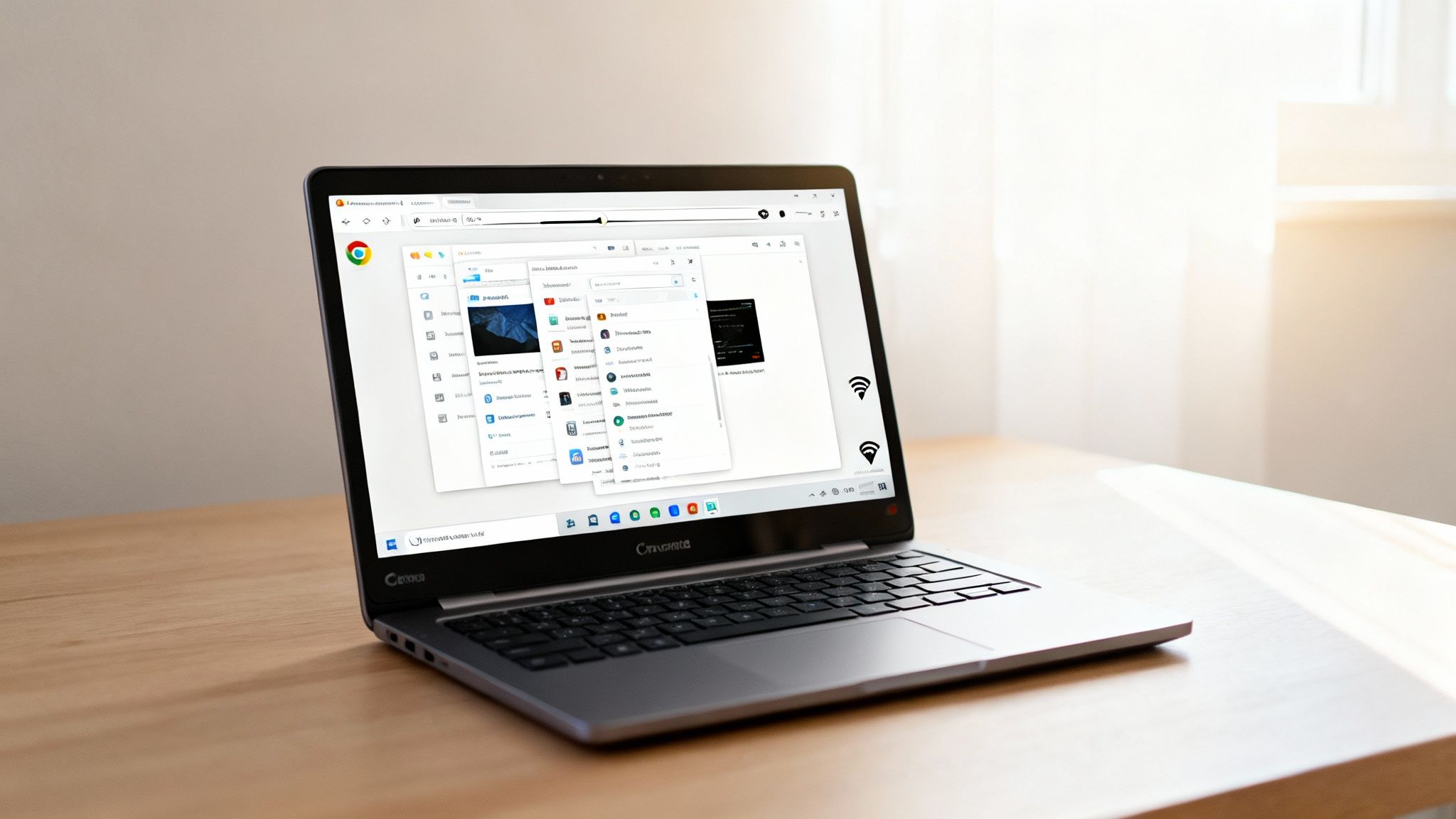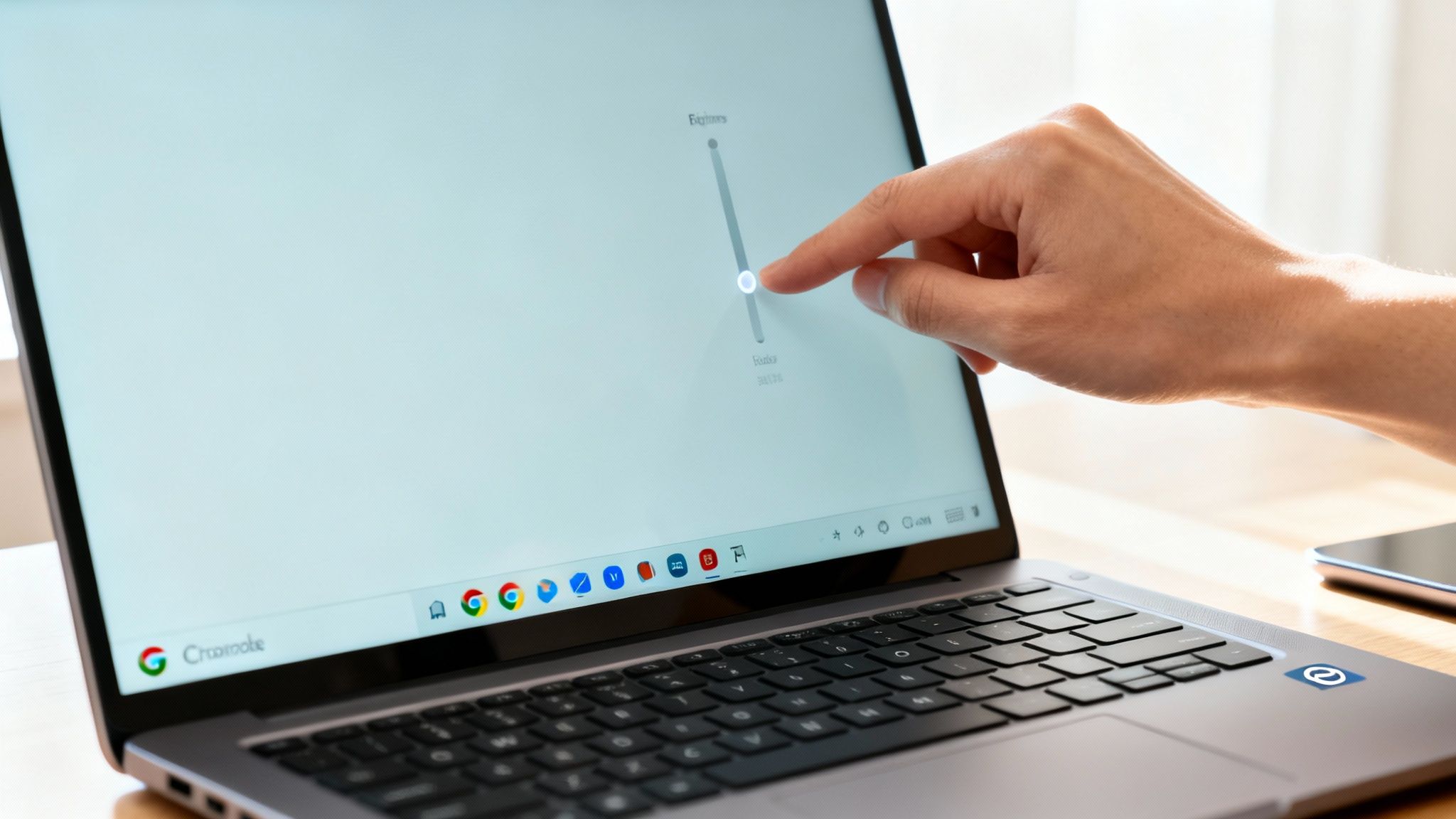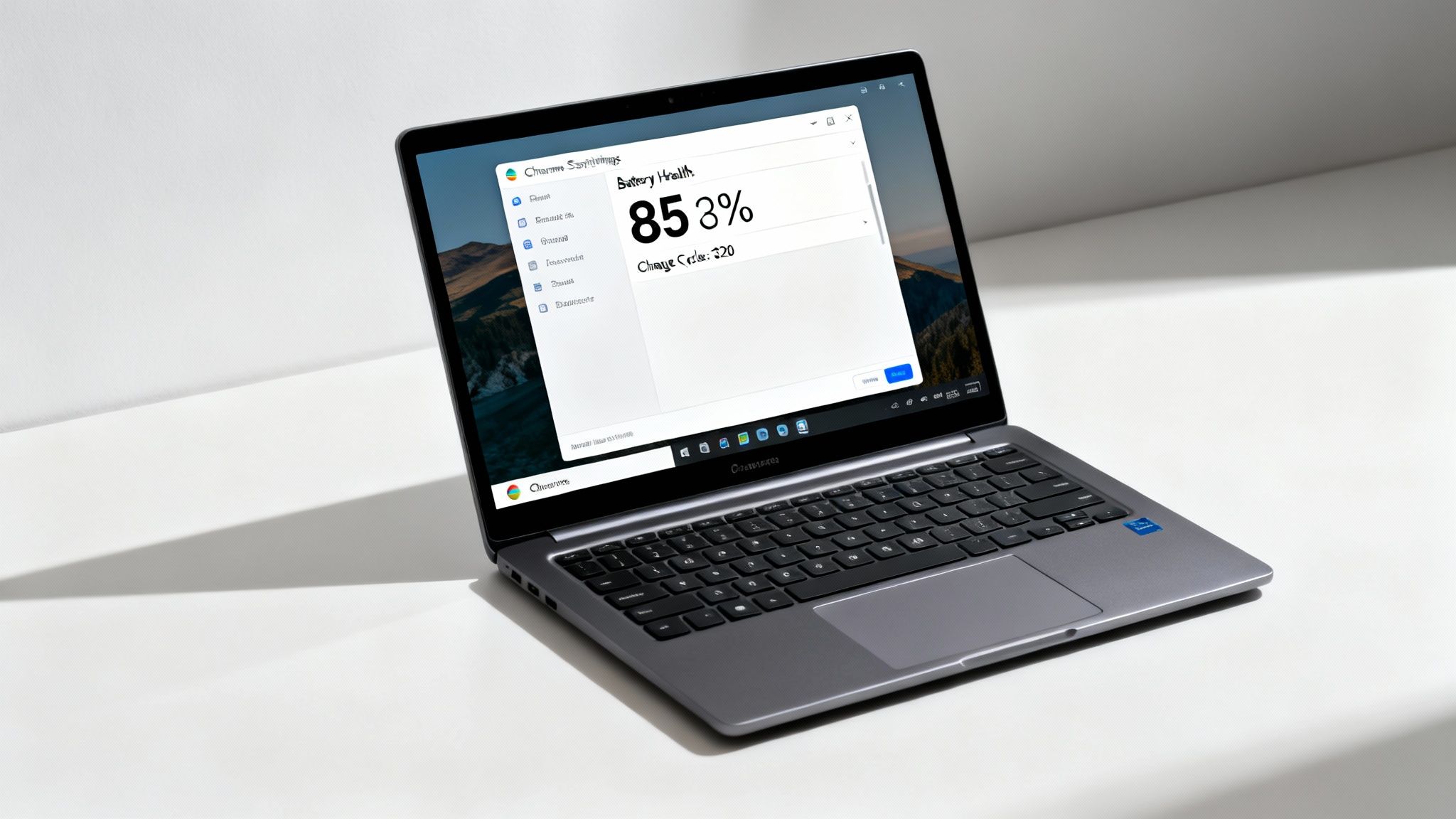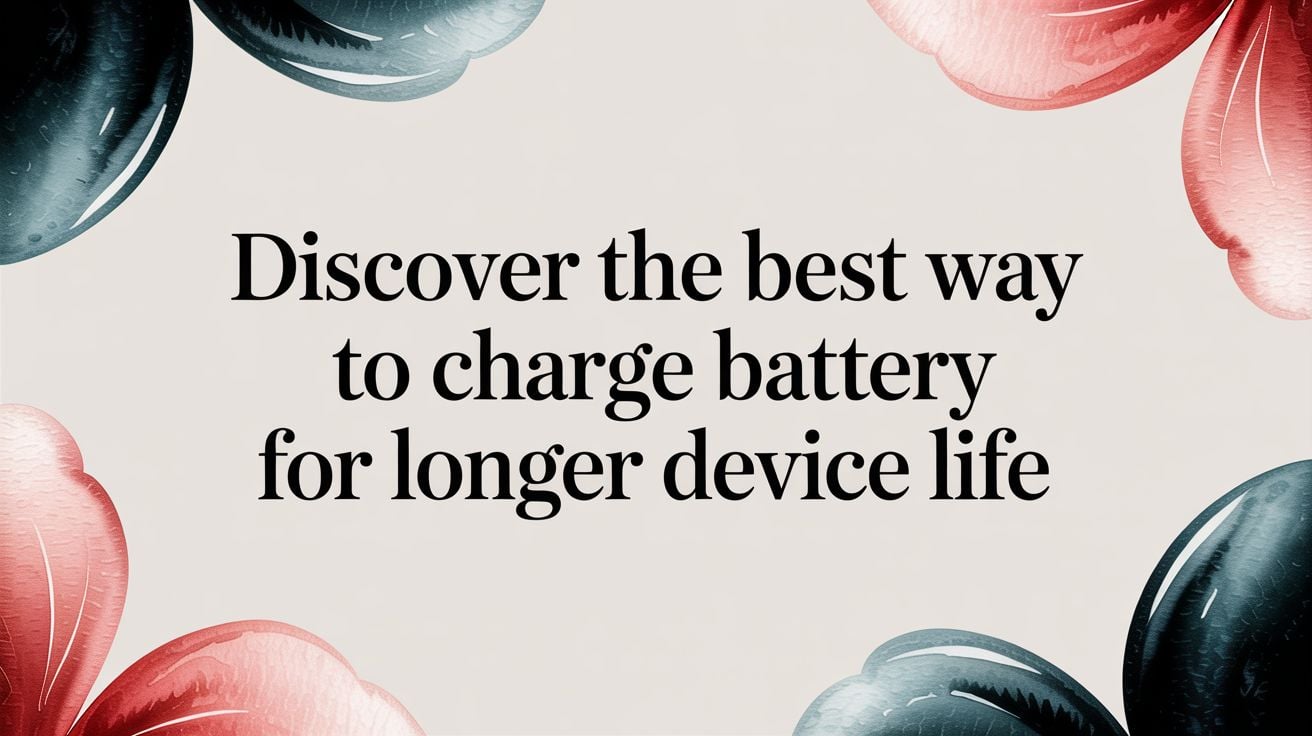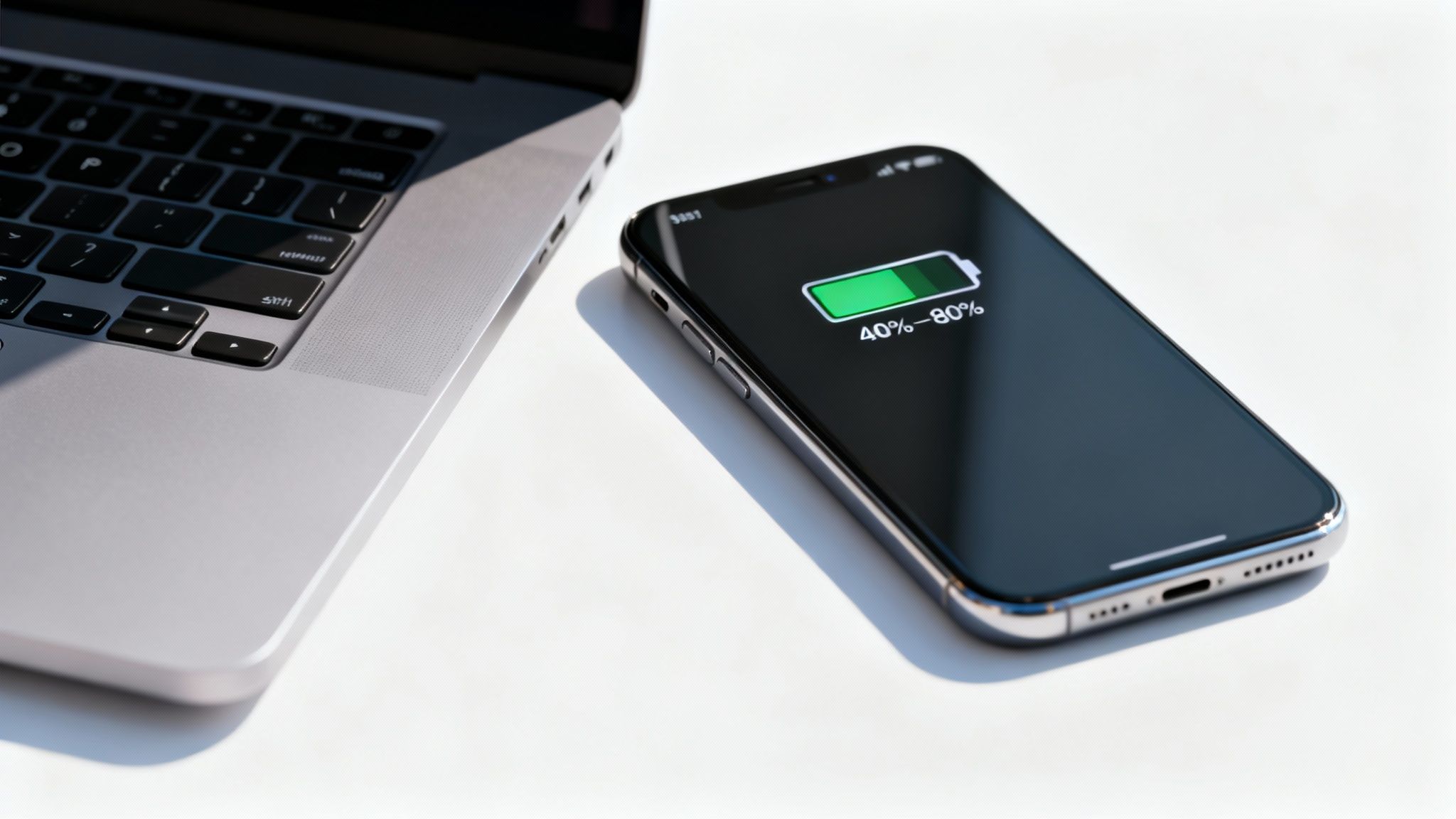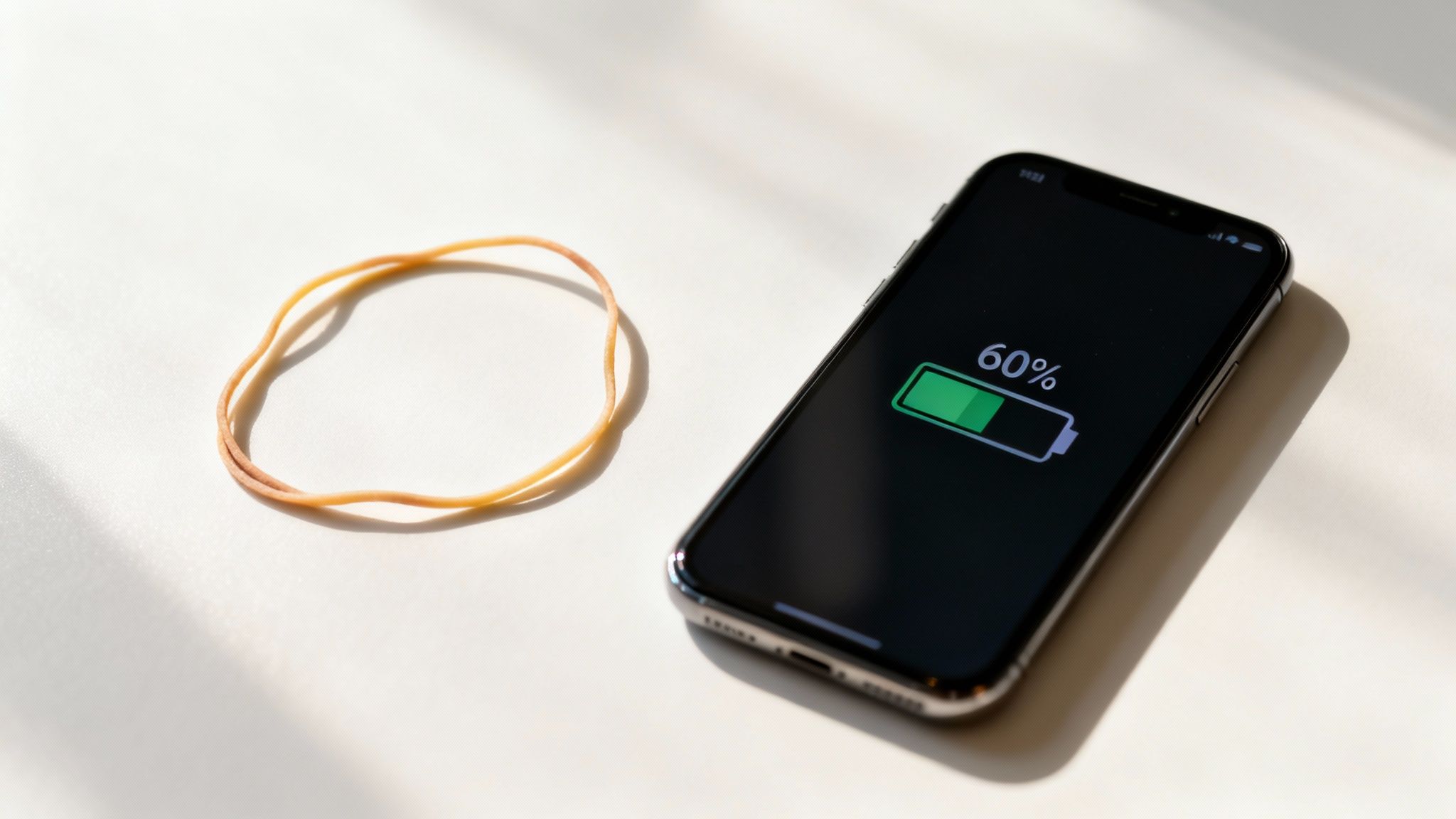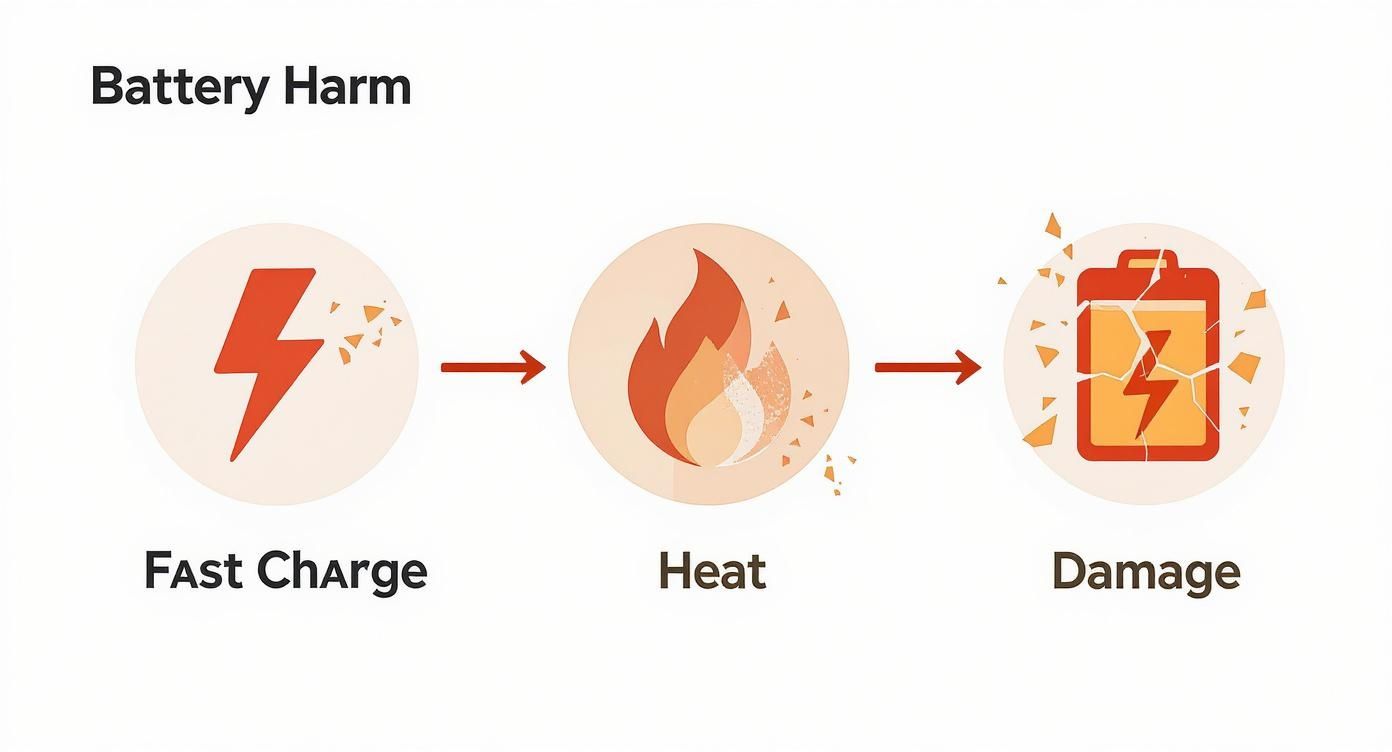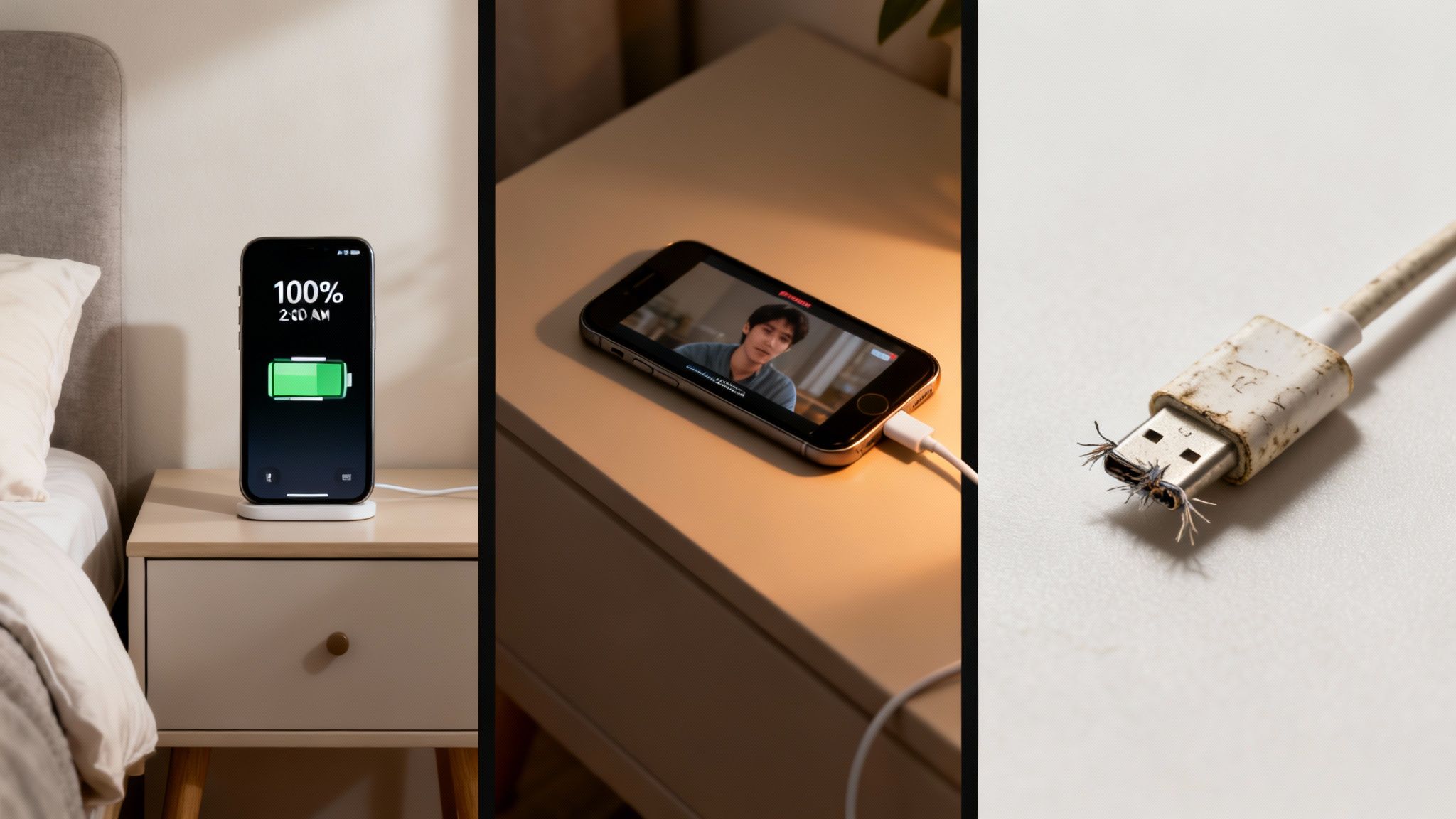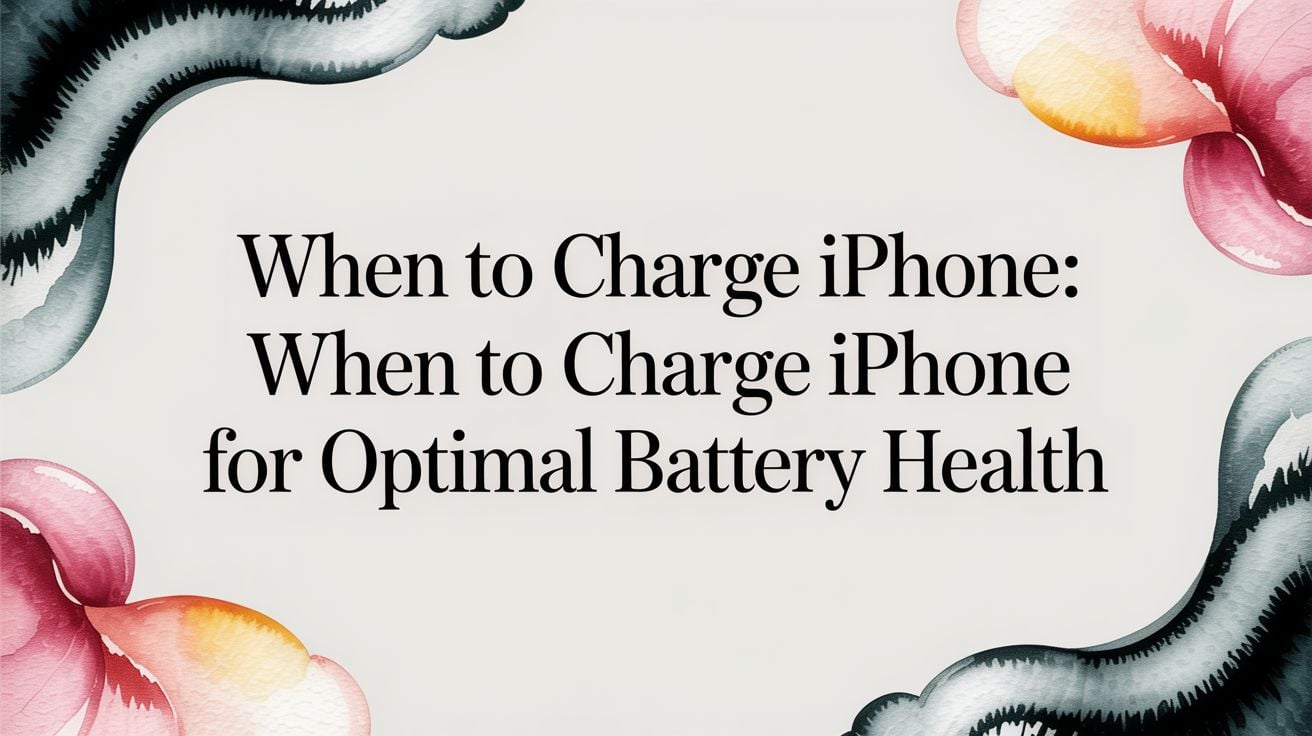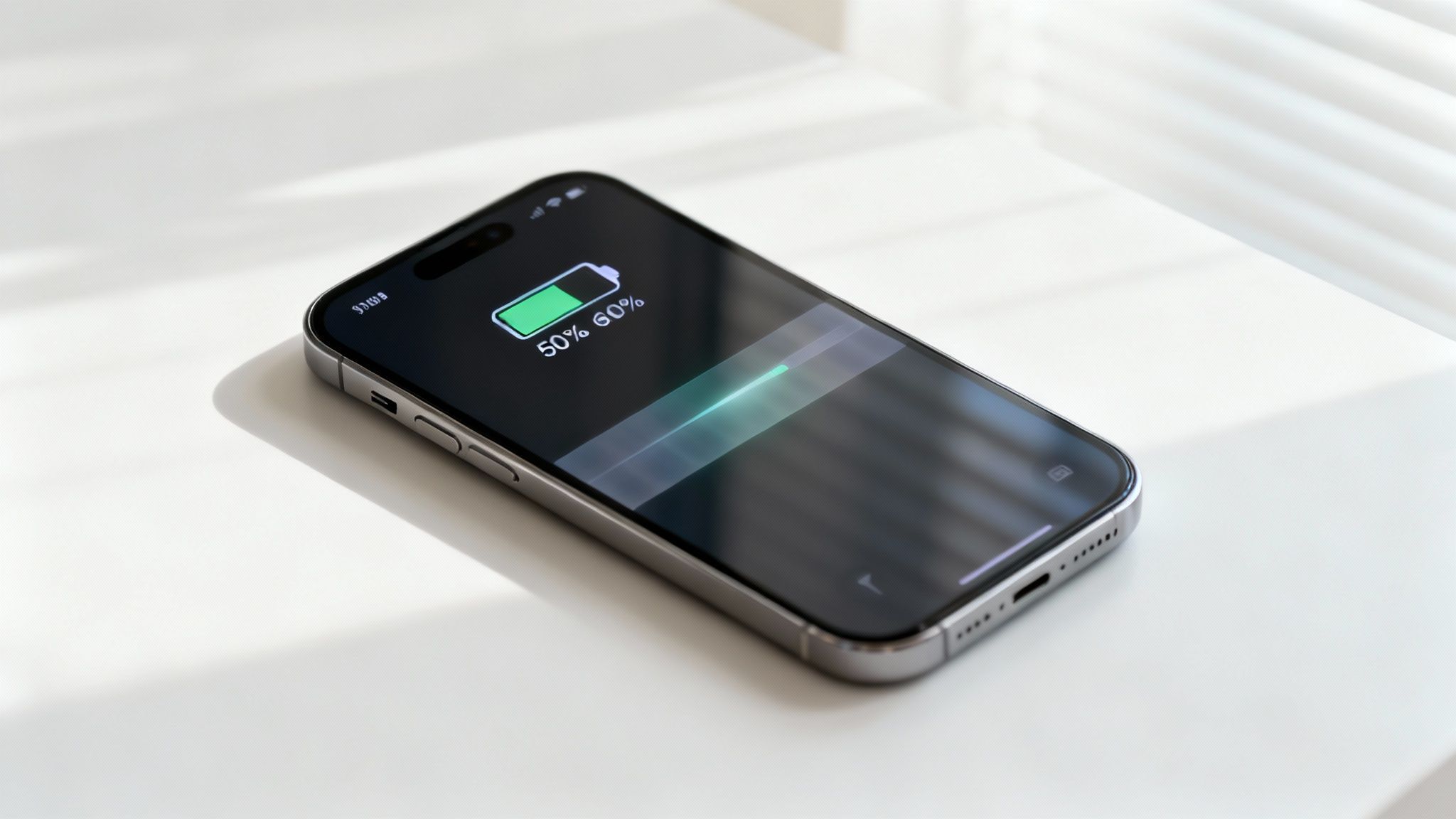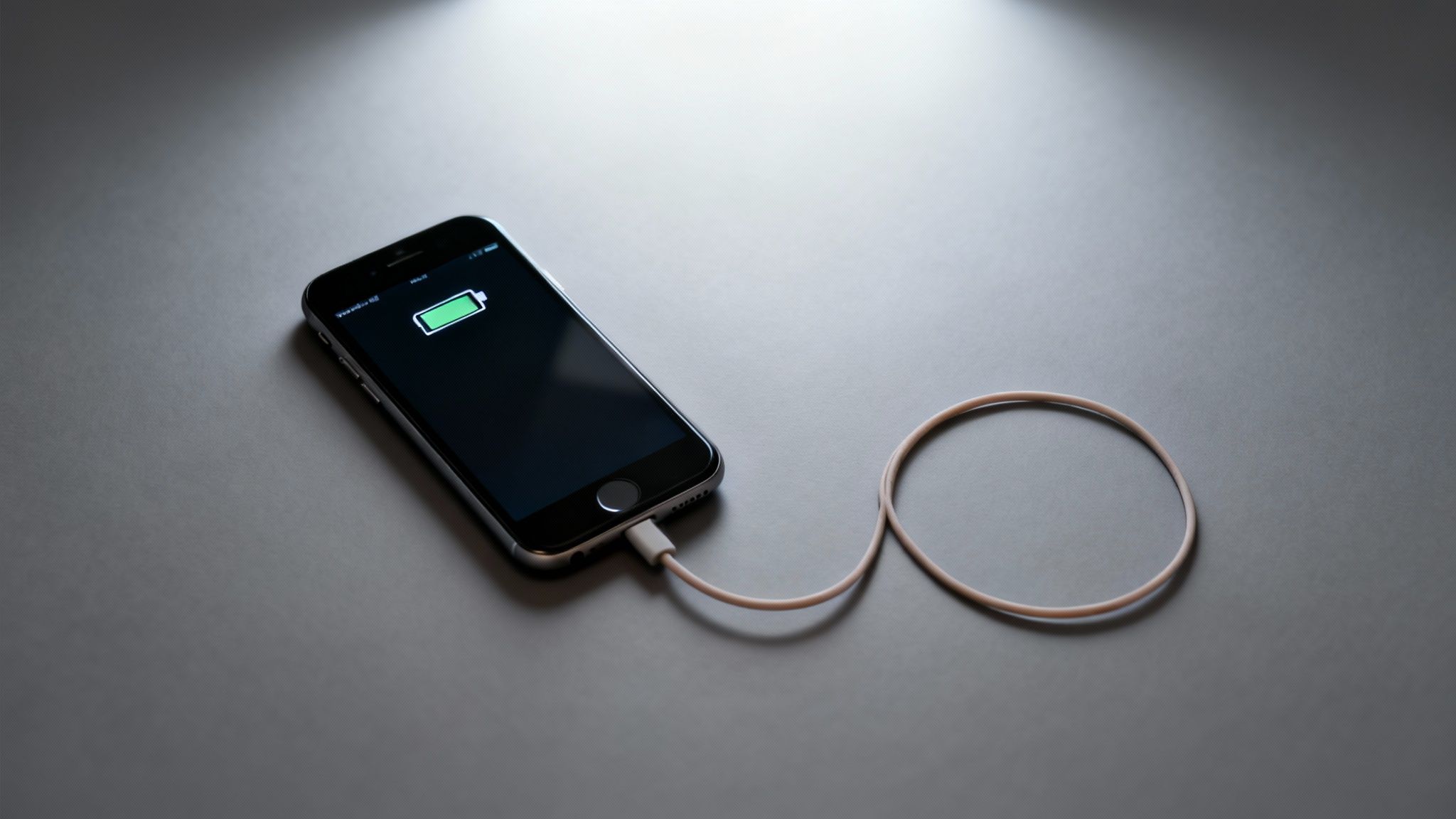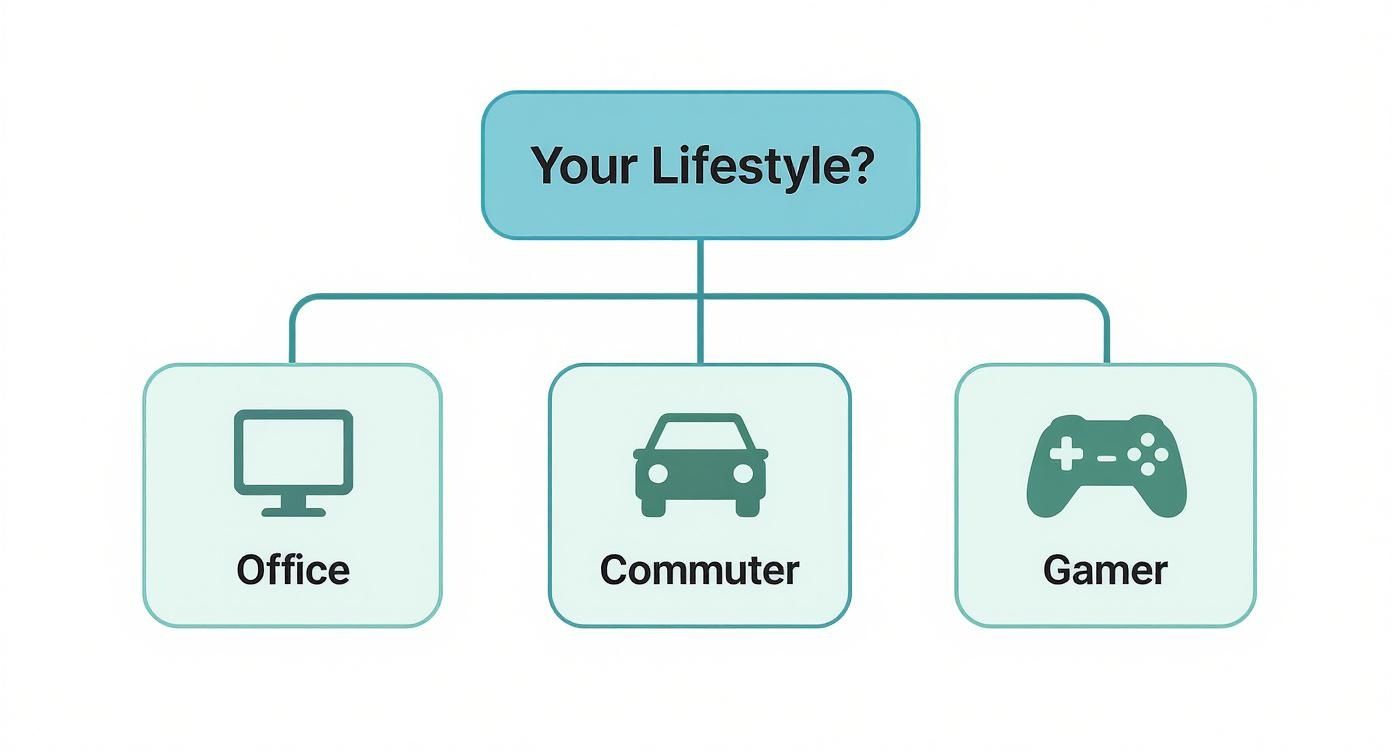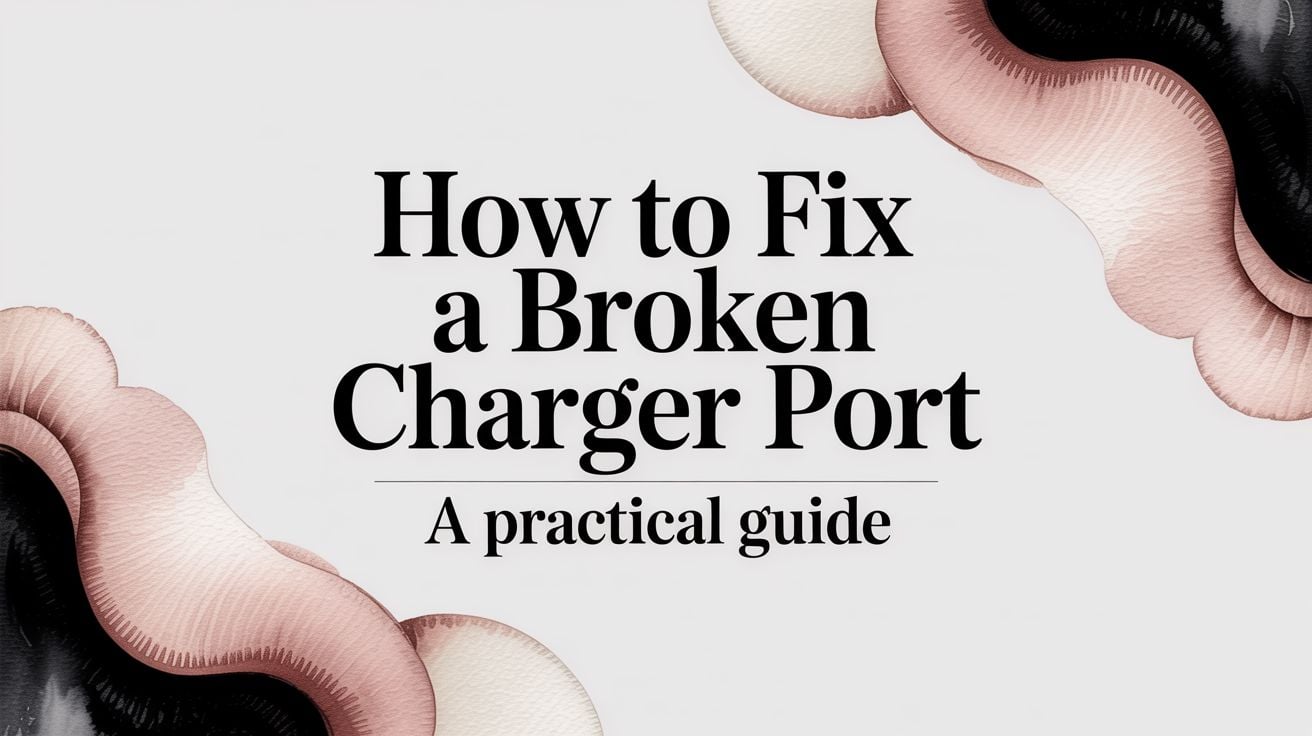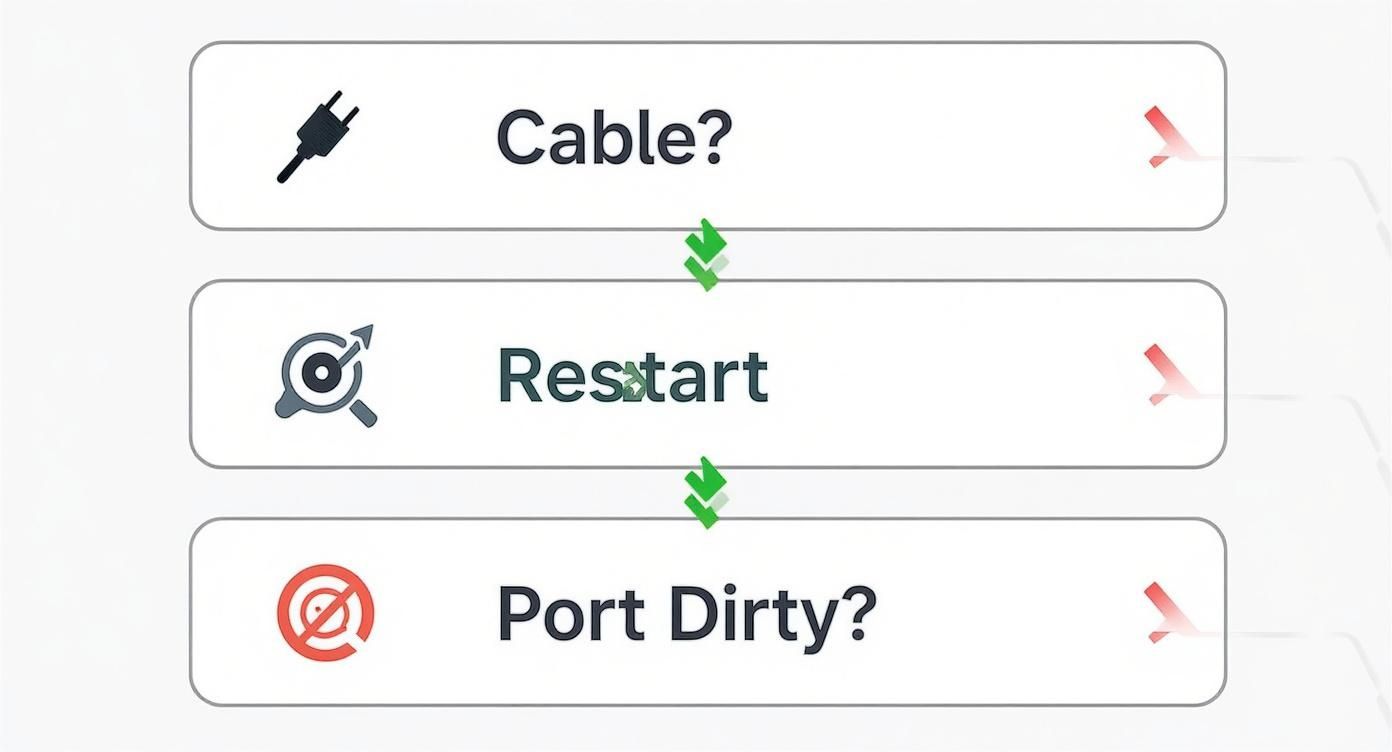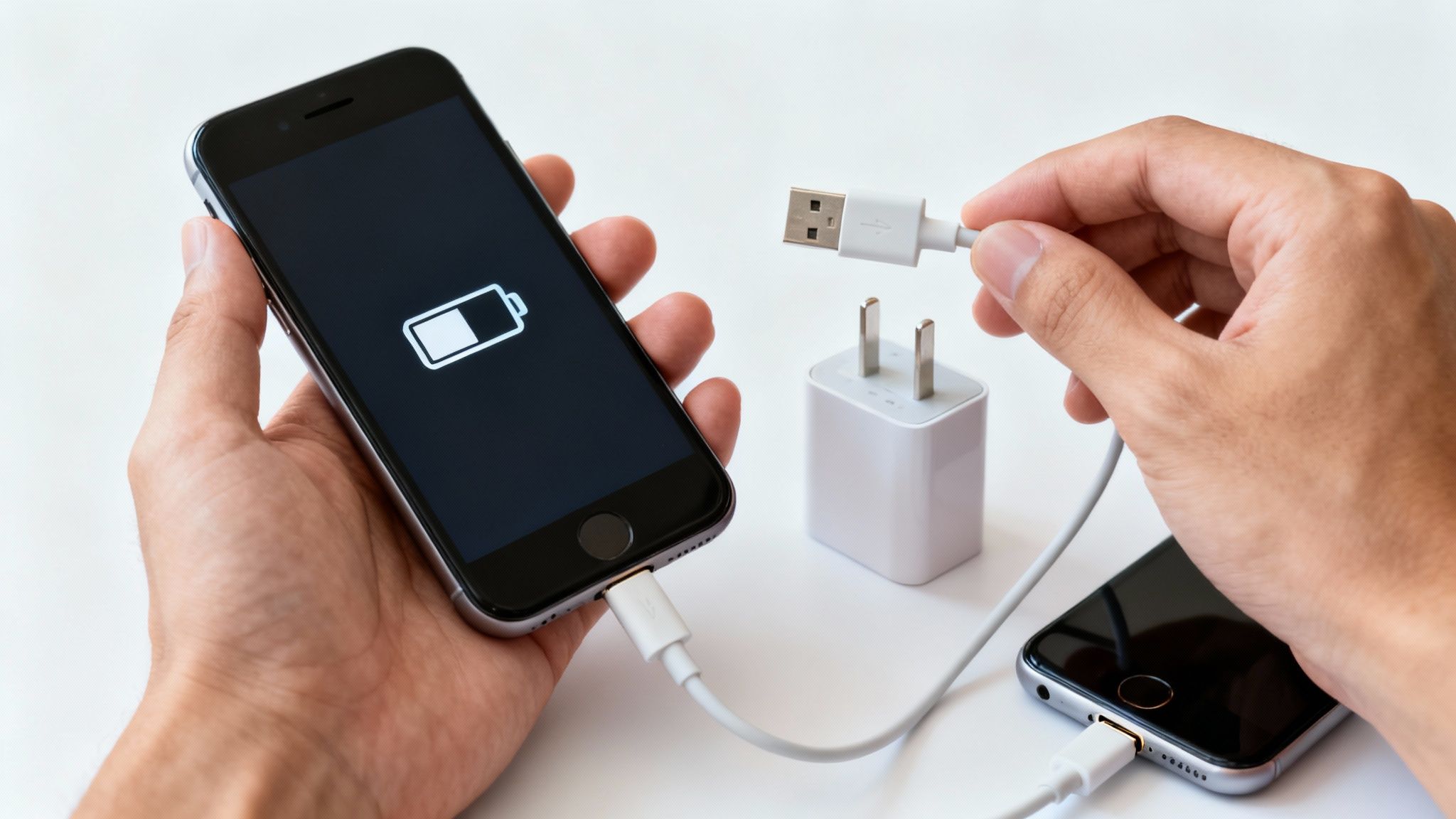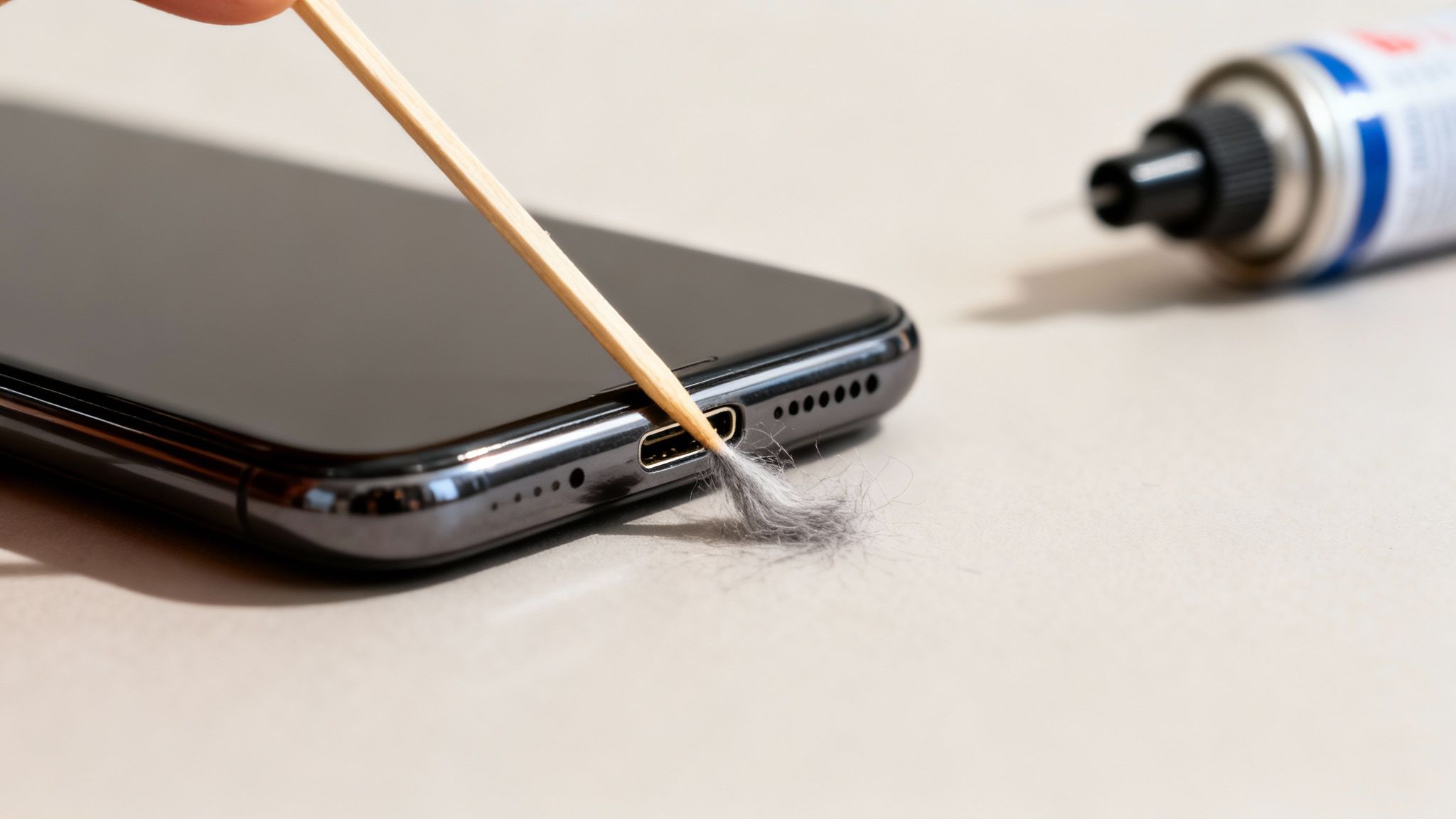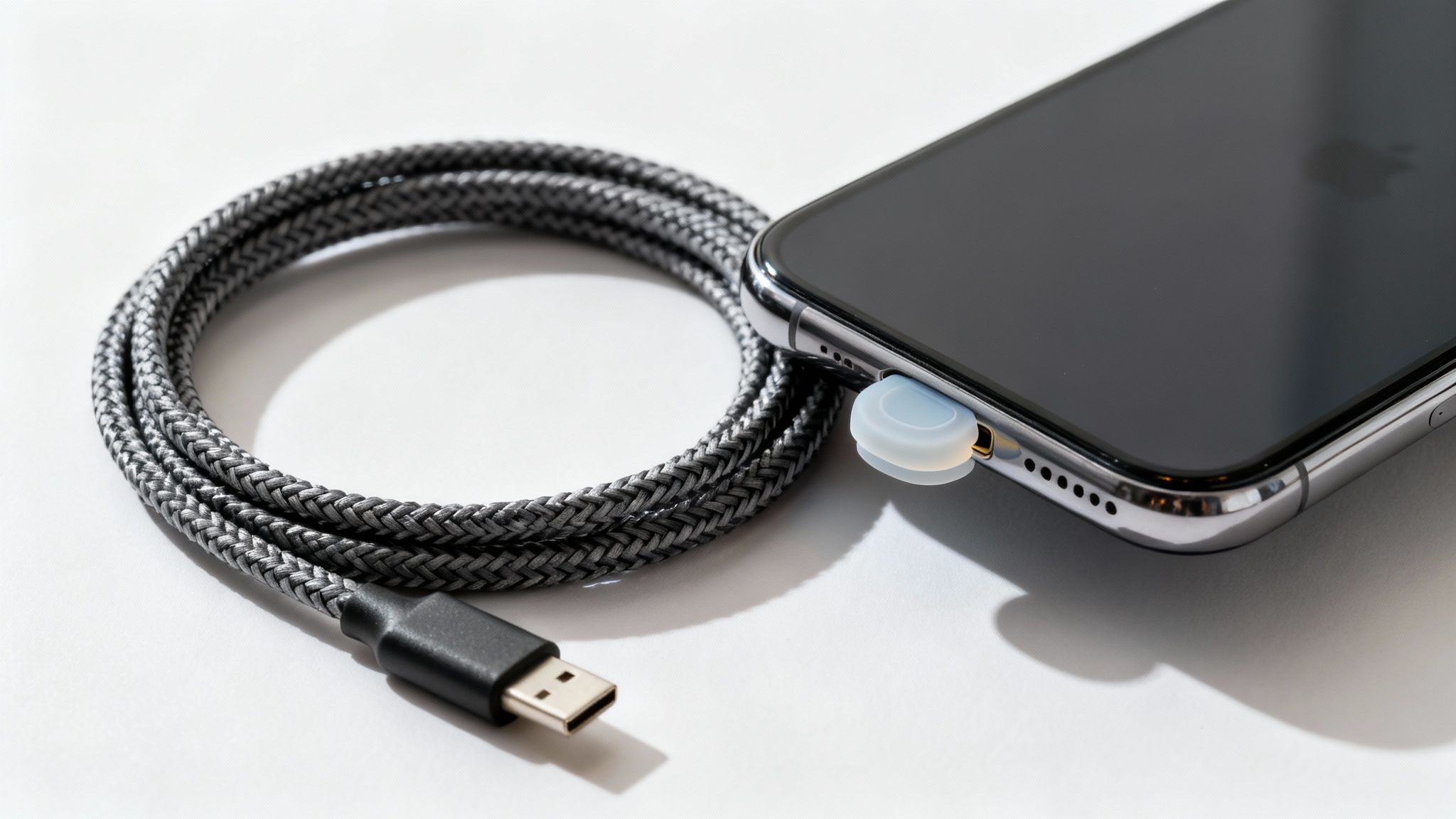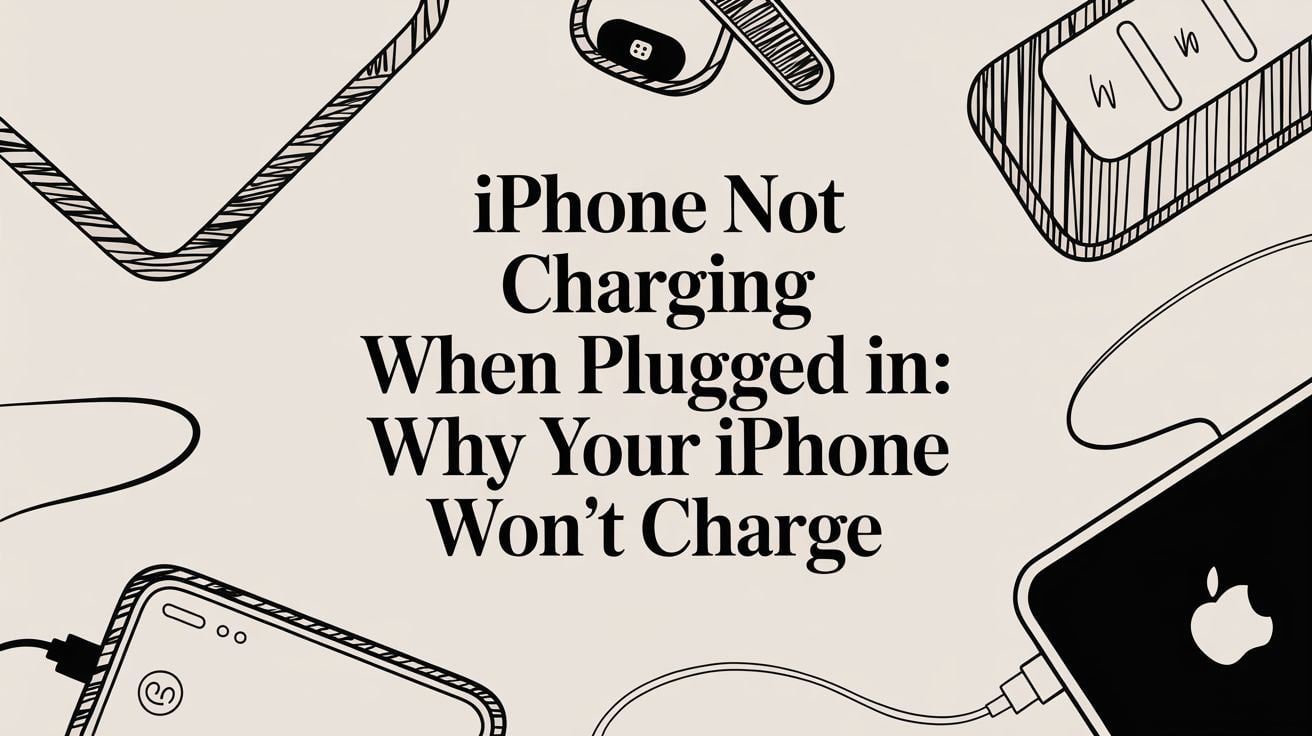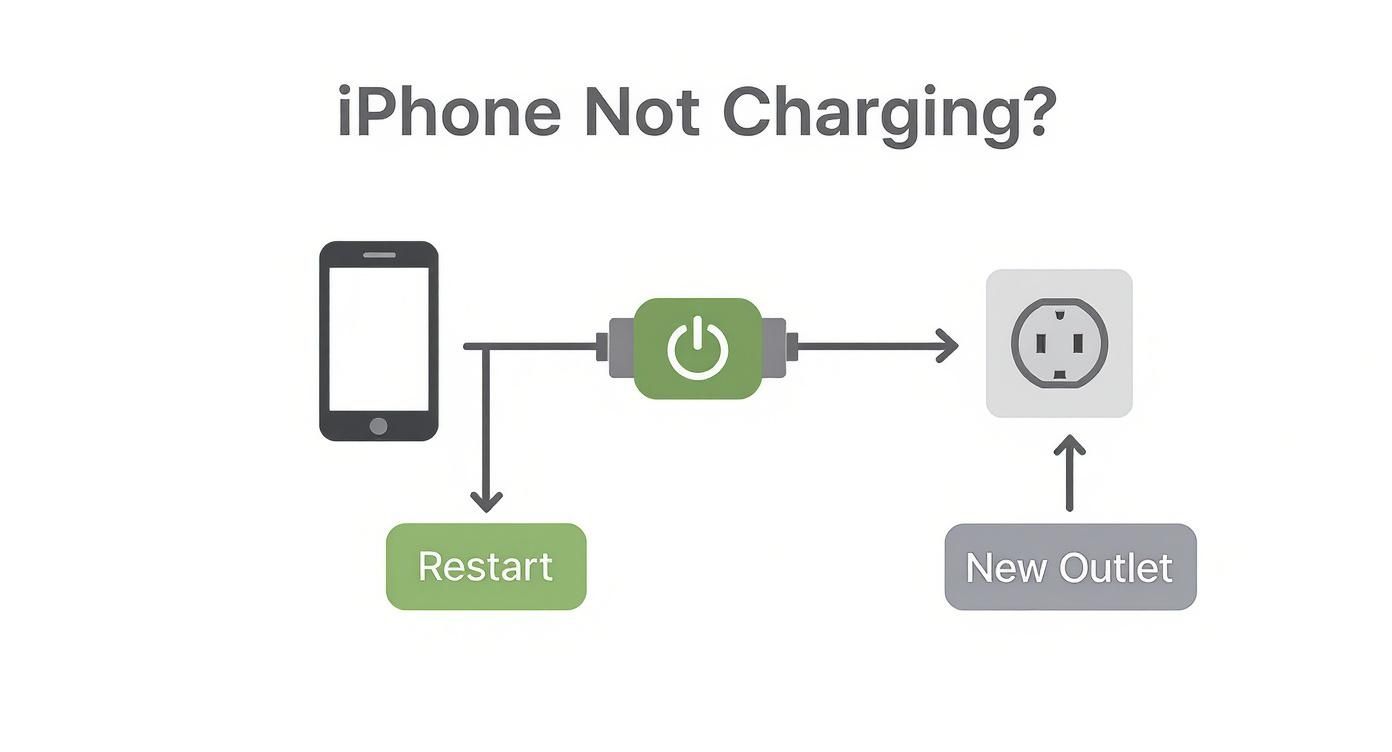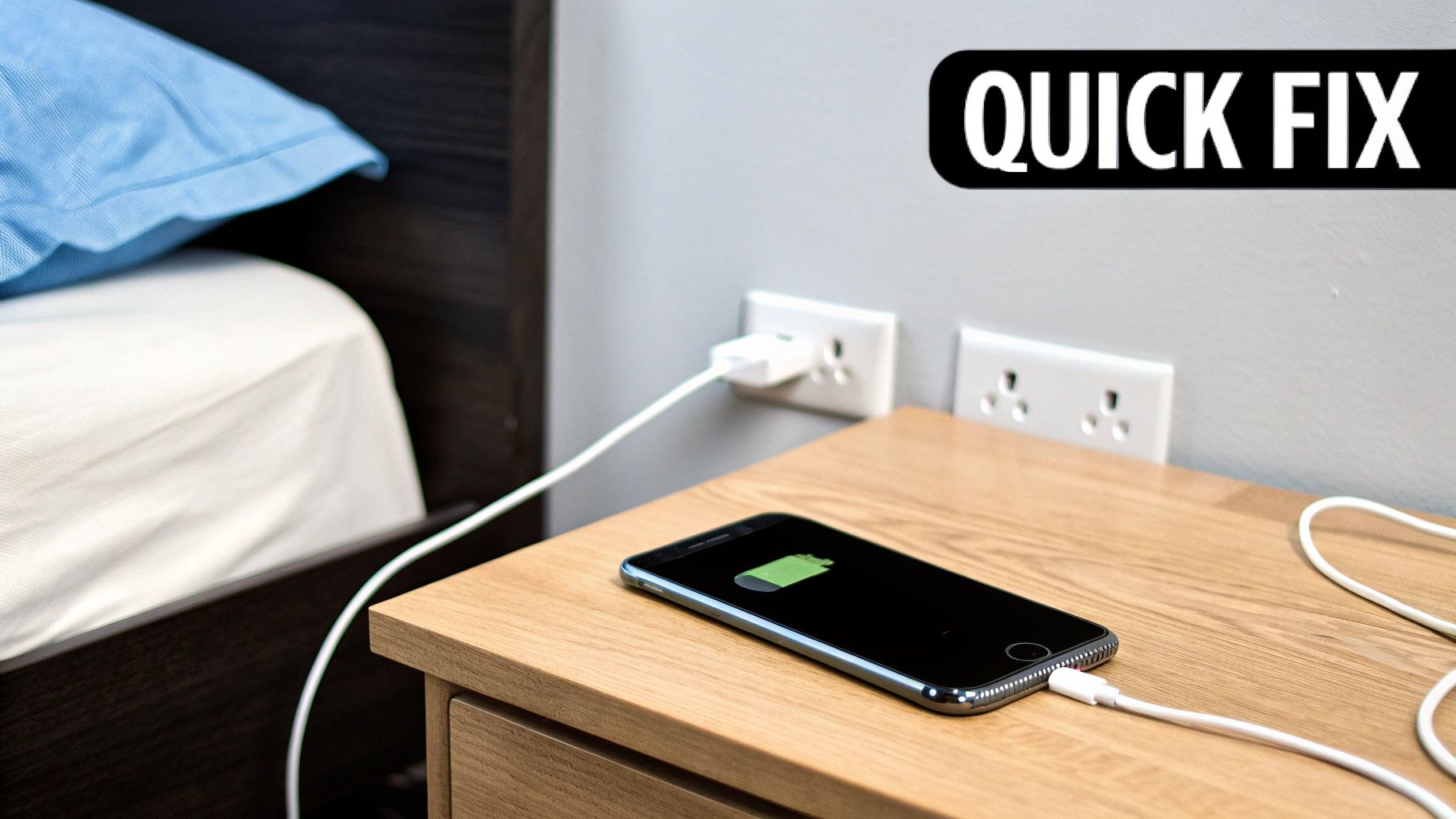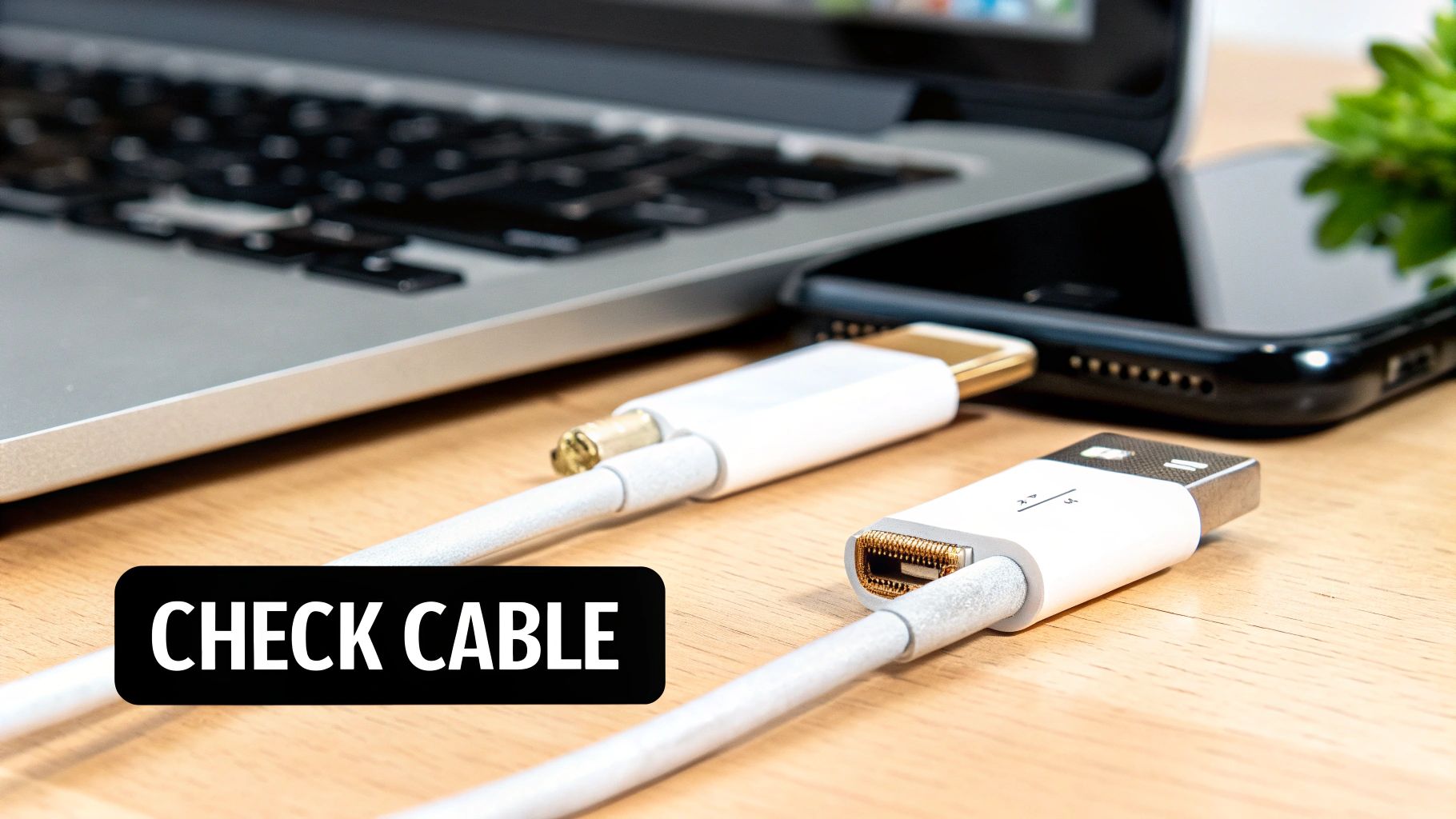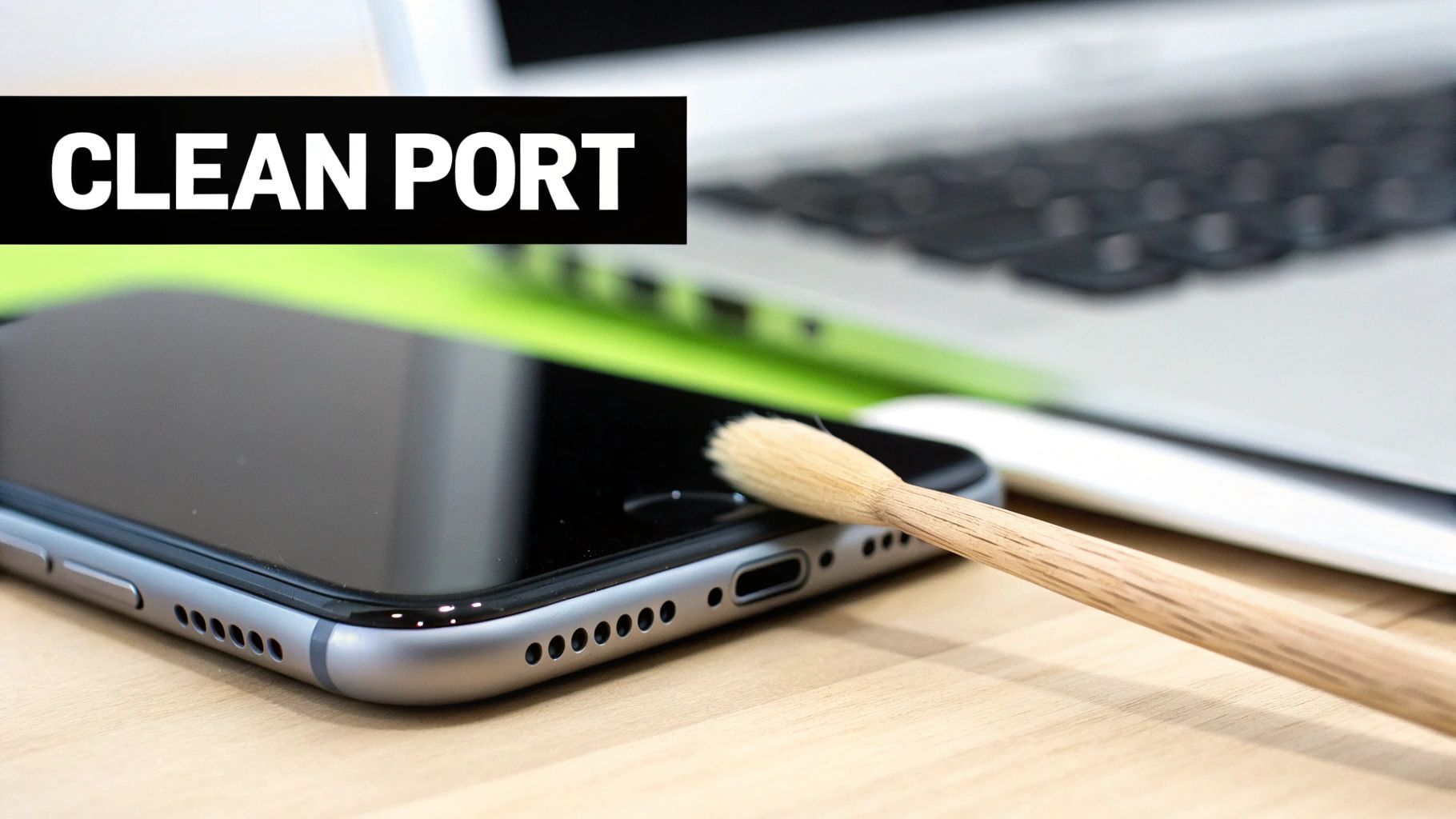How to Reset iPhone Battery Health and Recalibrate Your Device
If your iPhone suddenly shuts down at 20% or the battery percentage seems to jump around, you're likely dealing with a reporting problem. The first and easiest thing to try is a full recalibration. This just means letting the battery run all the way down and then charging it all the way back up in one go.
This process helps the phone's software relearn the battery's true empty and full points, giving you a much more accurate reading. It's a software fix, not a hardware miracle, but for strange battery behavior, it’s often the perfect solution.
What a Battery "Reset" Really Does for Your iPhone
Has your iPhone ever died on you, even when the battery icon showed plenty of power left? It’s a very common problem. People often look for a magic "reset" button, hoping to bring their battery back to its brand-new performance.
The truth is, you can't magically add life back to an old, worn-out battery. A "battery reset" is all about recalibrating the software that shows you the charge level. Think of it like fixing a broken fuel gauge in your car. The amount of gas in the tank doesn't change, but now the gauge is telling you the truth again.
This simple process helps your iPhone get a fresh, accurate measurement of the battery's true high and low points. Over time, things like your charging habits and software updates can cause the system to get confused, which leads to those strange percentages you see on screen.
Why Your Battery Percentage Can Be So Deceiving
That percentage you see in the corner of your screen? It’s just a software estimate, and a few things can easily throw it off.
- Weird Charging Habits: Constantly charging your phone from 40% to 70% and never letting it charge fully or die can confuse the software about its true range.
- Software Updates: A big iPhone update can sometimes mess up the battery reporting system. It’s like it gets temporary amnesia.
- An Aging Battery: As a battery gets older, its maximum capacity shrinks. If the software hasn't been recalibrated, it might still think the battery is bigger than it actually is.
The whole point of a battery reset, or recalibration, is to get the software's understanding back in sync with the battery's actual physical state. This makes the percentage you rely on trustworthy again, preventing those sudden, unexpected shutdowns.
Is It a Software Glitch or a Worn-Out Battery?
Knowing the difference here is key. If you’re dealing with a software issue, recalibration can feel like magic. But if the battery itself is physically worn out, no software trick is going to bring it back.
A helpful tip: Apple designs iPhone batteries to keep up to 80% of their original capacity after 500 full charge cycles. Once a battery drops below that, its ability to hold a charge drops quickly, and recalibration won't do much.
Apple even released a special update for iPhone 11 models that recalibrated the battery health system to fix very inaccurate estimates some users were seeing. You can read up on how Apple handles battery health and reporting on their official support page.
Before you jump into the how-to steps, it helps to figure out what you're dealing with. A software problem usually shows different signs than a genuinely failing battery.
Software Glitch vs. Failing Battery: What's the Difference?
Use this quick table to figure out if you're dealing with a software issue that recalibration can fix or a hardware problem that needs a new battery.
| Symptom | Likely a Software Problem | Likely a Failing Battery |
|---|---|---|
| Sudden Shutdowns | Dies unexpectedly at 10%, 20%, or even higher percentages. | Dies at very low percentages (1-2%) or won't turn on at all. |
| Jumping Percentage | Drops from 50% to 20% in an instant, or jumps up when plugged in. | Drains very quickly and predictably, but doesn't jump around. |
| Battery Health Reading | "Maximum Capacity" in Settings is still high (e.g., above 85%). | "Maximum Capacity" is below 80% or shows a "Service" warning. |
| Performance | Phone is generally fast, but the battery meter is just unreliable. | Phone feels sluggish, apps crash, and it may get unusually hot. |
| Physical Appearance | The phone looks perfectly normal. | The screen might be slightly lifted or the case bulging (serious!). |
By figuring out the main cause now, you can set realistic expectations. You'll know if you’re on the right path with a simple recalibration, or if you need to start thinking about a battery replacement.
How to Recalibrate Your iPhone Battery the Right Way
When your iPhone's battery percentage feels more like a random number than a reliable guide, it's time to force a reset. We're not talking about a factory reset that wipes your data, but a manual recalibration. This process essentially teaches your iPhone the true top and bottom limits of your battery all over again, wiping its faulty memory and replacing it with accurate data.
Think of it like resetting the trip counter in your car. By forcing one complete charge cycle—draining the battery completely and then filling it back up without stopping—you’re giving the software a fresh start. This is the key to getting a percentage you can actually trust.
This process takes your battery reading from confusing to accurate. It's a simple, but effective fix.
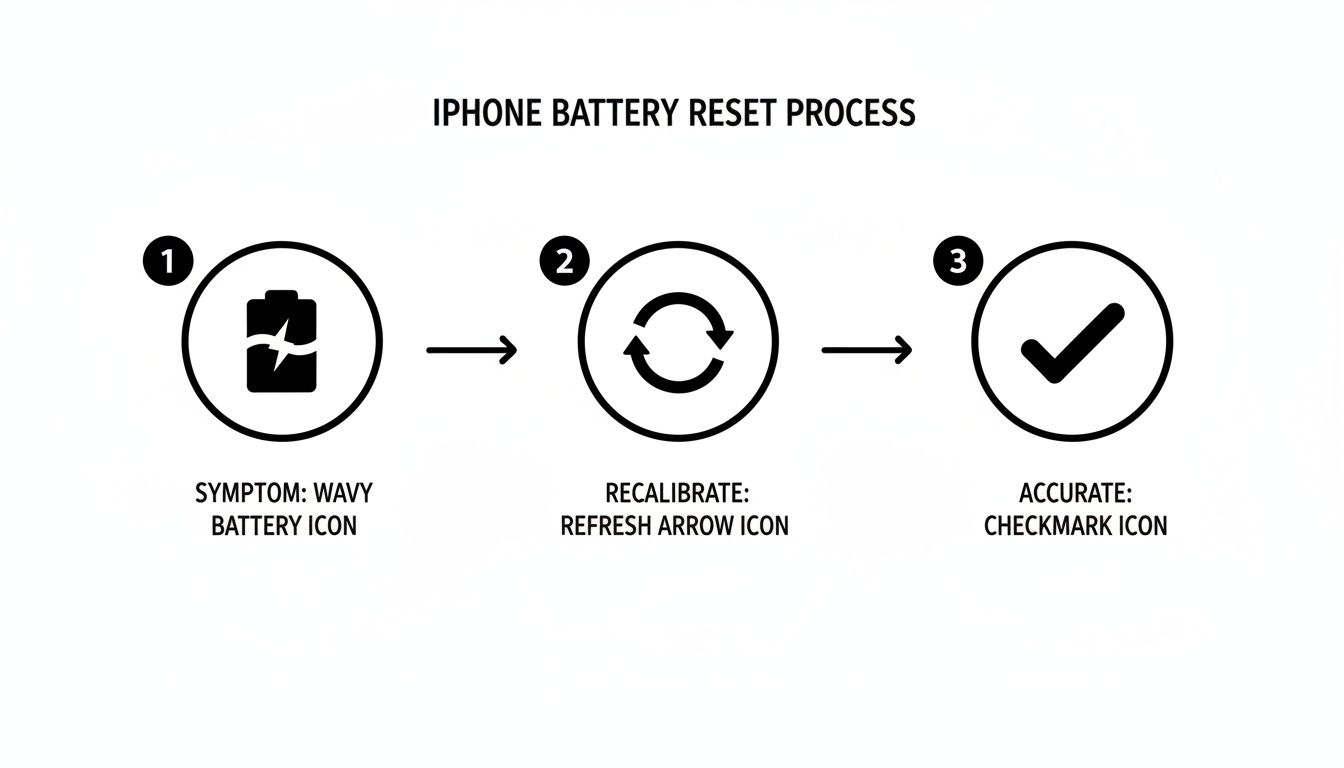
As you can see, you start with a problem (an unreliable battery), perform the recalibration, and end up with a dependable percentage.
The Full Drain Method Explained
First things first: you have to completely drain the battery. And I mean completely. Use your phone until it shuts itself off. Don't be tempted to plug it in when you see that 1% warning. You need to let it go all the way to zero on its own.
To speed things up, you can do things that use a lot of power. Try turning the screen brightness to max, streaming a long YouTube video, or playing a graphics-heavy game. The goal is to make the phone work hard until it powers down.
Once it’s off, the job isn't quite done. A tiny bit of power can still be left, so it’s important to let the phone sit, unplugged, for at least three to four hours. This step makes sure every last drop of power is gone, giving the system a true "empty" starting point to learn from.
Charging Your Way to Accuracy
After the phone has had a good rest, it's time to charge it. This part of the process is just as important as the draining part, and you have to follow a few rules to get the best results.
- Use an Official Charger: Stick with an official Apple charger and cable or a certified MFi (Made for iPhone) accessory. This ensures your phone gets a stable, correct charge, which is important for both calibration and long-term battery health.
- Charge Without Interruption: This is a big one. Plug your iPhone in and let it charge all the way to 100% without using it. Answering a text or scrolling through Instagram can disrupt the charging cycle and mess up the recalibration.
- Let It "Soak" Charge: Once the screen shows 100%, don't unplug it just yet. Leave it connected to the charger for another one to two hours. This is sometimes called a "soak" or "trickle" charge, and it makes sure the battery is truly, completely full.
This uninterrupted cycle—from absolute zero to a fully soaked 100%—gives your iPhone the new, accurate data it needs. The ideas are surprisingly similar for other devices; in fact, you can learn more about how to calibrate a laptop battery using a similar process.
Key Takeaway: The whole point of recalibration is to erase the old, inaccurate battery data and replace it with a fresh measurement. You do this by forcing the battery through one complete, uninterrupted cycle from a true empty state to a true full state.
Finalizing the Recalibration Process
Once your iPhone has had its soak charge, there's one last quick step to help lock in the new calibration data. A simple restart can help the system fully register the changes you’ve just made.
The method for a restart varies slightly depending on your iPhone model:
- For iPhones with Face ID (iPhone X and newer): Quickly press and release the Volume Up button, then quickly press and release the Volume Down button. Finally, press and hold the Side button until you see the Apple logo.
- For iPhones with a Home Button (iPhone 8, SE): Press and hold both the Home button and the Side (or Top) button at the same time. Keep holding them until the Apple logo appears on the screen.
After the phone reboots, your battery percentage should be much more reliable. This single recalibration cycle is often all it takes to fix those strange readings and prevent frustrating, unexpected shutdowns.
Alright, if a full battery recalibration didn't fix your problems, your next stop is the iPhone’s own internal health report. This is where the phone tells you what it thinks is going on with the physical battery inside.
Head over to Settings > Battery > Battery Health & Charging. This screen gives you a surprisingly honest look at the condition of your battery, going beyond the simple percentage you see in your status bar.
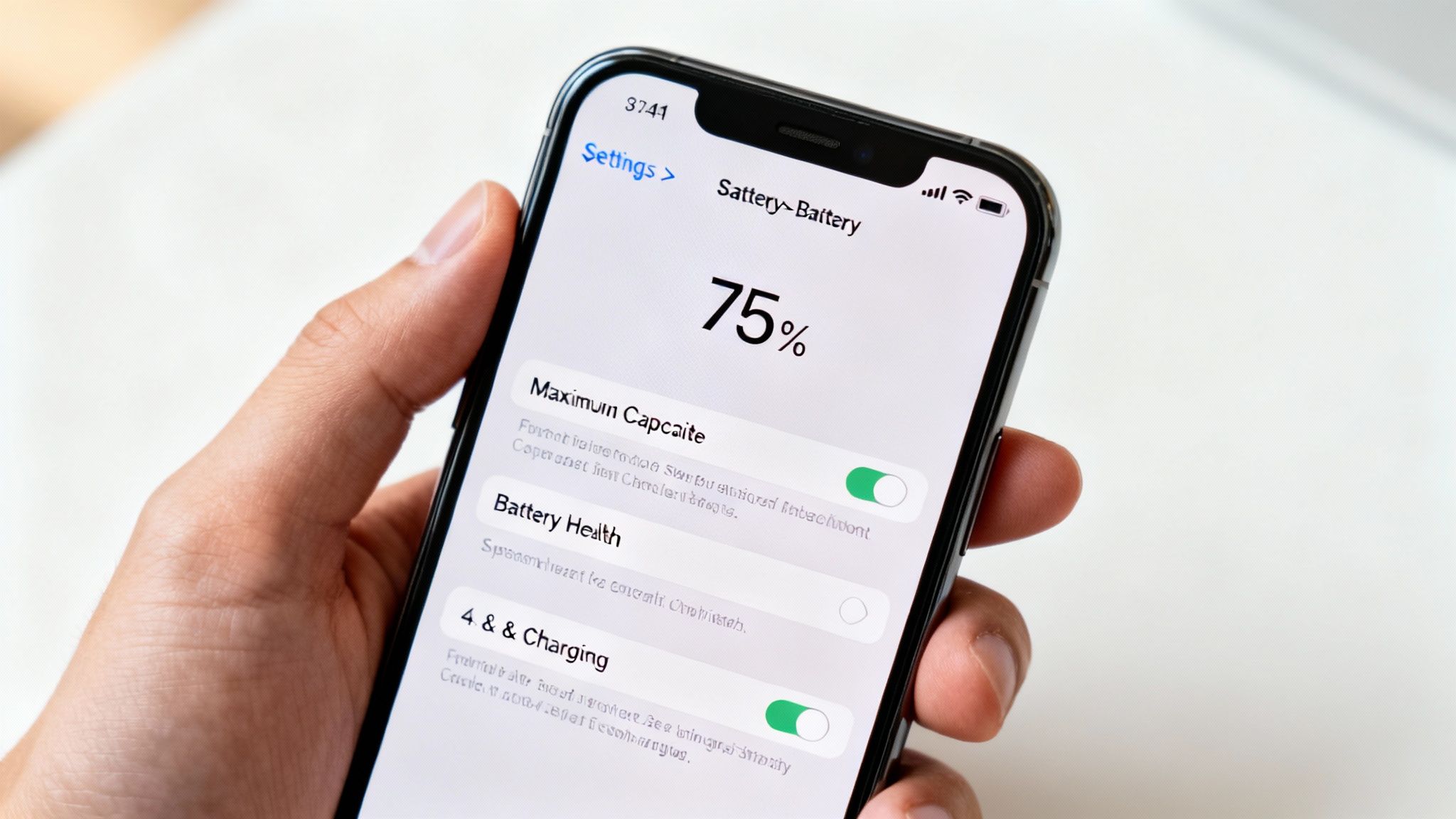
Understanding what these numbers and messages really mean is key. It helps you decide if a software fix is still possible or if it's time to think about more serious options.
What “Maximum Capacity” Actually Means
The first thing you'll see is the Maximum Capacity percentage. This isn't about your current charge level—it's a direct measure of your battery's health compared to the day it was new. A brand-new iPhone proudly shows 100%.
Over time, with every charge, that number naturally drops.
Think of it like a water bottle. When it’s new, it holds a full liter. After a few years of use, maybe it only holds 850ml. The bottle still works, but its total capacity has permanently shrunk. That’s exactly what this percentage is showing you.
Don't panic if it's not at 100%. Seeing 90% after a year of heavy use, or even 85% after two, is completely normal. It’s not a sign of a faulty battery; it's just how lithium-ion batteries work. We have a more detailed guide that digs deeper into how to check your iPhone's battery health and make sense of these numbers.
The Real Story: "Peak Performance Capability"
Just below the capacity number, you'll find the Peak Performance Capability section. Honestly, this is where the real story is. This message tells you if your battery can still supply enough power for demanding tasks like shooting 4K video or playing intense games.
Here’s a quick rundown of what you might see:
- Your battery is currently supporting normal peak performance. This is the best message. It means that no matter its maximum capacity, your battery can still handle anything you throw at it.
- Performance management has been applied. If you see this, it means your iPhone has unexpectedly shut down in the past. To prevent it from happening again, the phone is slowing down certain parts, like the main processor. It’s a safety feature.
- This iPhone has experienced an unexpected shutdown… This is a warning. It’s your phone telling you the battery is struggling to deliver the power needed for heavy tasks.
This entire screen exists to give you a clear, honest view of your battery's health and how it's affecting your phone's speed.
You might remember the "Batterygate" scandal. Apple was found to be secretly slowing down older iPhones to prevent shutdowns caused by aging batteries. After admitting to it in late 2017, they added this detailed battery health screen to be more open. That controversy led to a huge $500 million settlement and proved how much this information matters. If you're curious, the full history of the Batterygate scandal is on Wikipedia.
By looking at both the capacity and the performance message, you get the full picture. A phone at 82% capacity that’s still supporting normal peak performance is in far better shape than one at 88% that has performance management turned on. This is the knowledge you need to decide if a simple battery reset is enough, or if it’s finally time to consider a replacement.
What to Do When Recalibration Fails
So, you’ve patiently run your iPhone through a full drain-and-charge cycle, but the battery meter is still acting up. What now?
When a manual recalibration doesn't work, it’s a strong sign the problem is deeper in the software, not necessarily a sign that your battery is dead. Before you think about a trip to the Apple Store, there are a few more software fixes we can try, from simplest to most powerful.
First, Always Check for an iOS Update
Before you reset anything, your first move should be to check for a software update. Just head over to Settings > General > Software Update.
Apple is constantly releasing updates with bug fixes, and many of these are aimed at fixing battery drain bugs. What feels like a major hardware failure could just be a known software glitch that Apple has already patched. A quick update can save you a lot of trouble.
This is especially true right after a major iOS release. Big updates can cause temporary battery drain for many people. Apple has even confirmed this is expected, as the new software has to do heavy background work like re-organizing all your files and photos.
One survey showed that while 78% of users saw faster battery drain right after an update, 92% said their battery life was back to normal within three days. It just goes to show that a little patience after an update can go a long way. You can read more about how big iOS updates impact battery life at the Economic Times.
Next, Try Resetting All Settings
If your iPhone has the latest software and the battery meter is still wrong, it’s time to try Reset All Settings.
This option sounds scarier than it is. It does not delete any of your personal data—your photos, apps, messages, and contacts are all safe.
What it does do is wipe all your system settings back to their original defaults. This means things like Wi-Fi passwords, Bluetooth connections, screen brightness, and notification settings will be cleared out. It’s a great way to fix strange software conflicts that might be causing battery reporting issues, all without touching your important data.
Here’s where to find it:
- Go to Settings > General > Transfer or Reset iPhone.
- Tap Reset, then Reset All Settings.
You’ll need to enter your passcode to confirm. Once your iPhone restarts, you'll have to reconnect to your Wi-Fi and change a few of your settings again, but it's a small price to pay for a big potential fix.
The Final Software Fix: A Factory Reset
If you’ve tried everything else, the factory reset is your last resort. Think of this as the "nuclear" option. It completely erases your iPhone, returning it to the fresh, out-of-the-box state it was in when you first got it.
Warning: This step cannot be undone and will delete everything—apps, photos, messages, settings, all of it. Before you even consider this, you absolutely must have a complete, recent backup of your iPhone, either on iCloud or on your computer.
Once you’re sure your backup is complete and safe, head to Settings > General > Transfer or Reset iPhone > Erase All Content and Settings.
After the reset is done, you'll set up your iPhone as if it were new and then restore your data from that backup. This clean-slate approach is often the only way to get rid of deep-seated software problems. If even this doesn't solve the issue, then you can be pretty sure the problem is with the battery itself, and it’s time to look into getting it replaced.
Simple Habits for Better Long-Term Battery Health
Okay, so you’ve successfully recalibrated your iPhone's battery. That's a great feeling, but the real win is learning how to avoid battery problems in the first place.
Building a few simple habits can make a huge difference in your battery's lifespan. We're talking about keeping its performance strong and avoiding an expensive replacement for as long as possible. These are just small tweaks to your daily routine that protect your battery from the very things that wear it down the fastest.
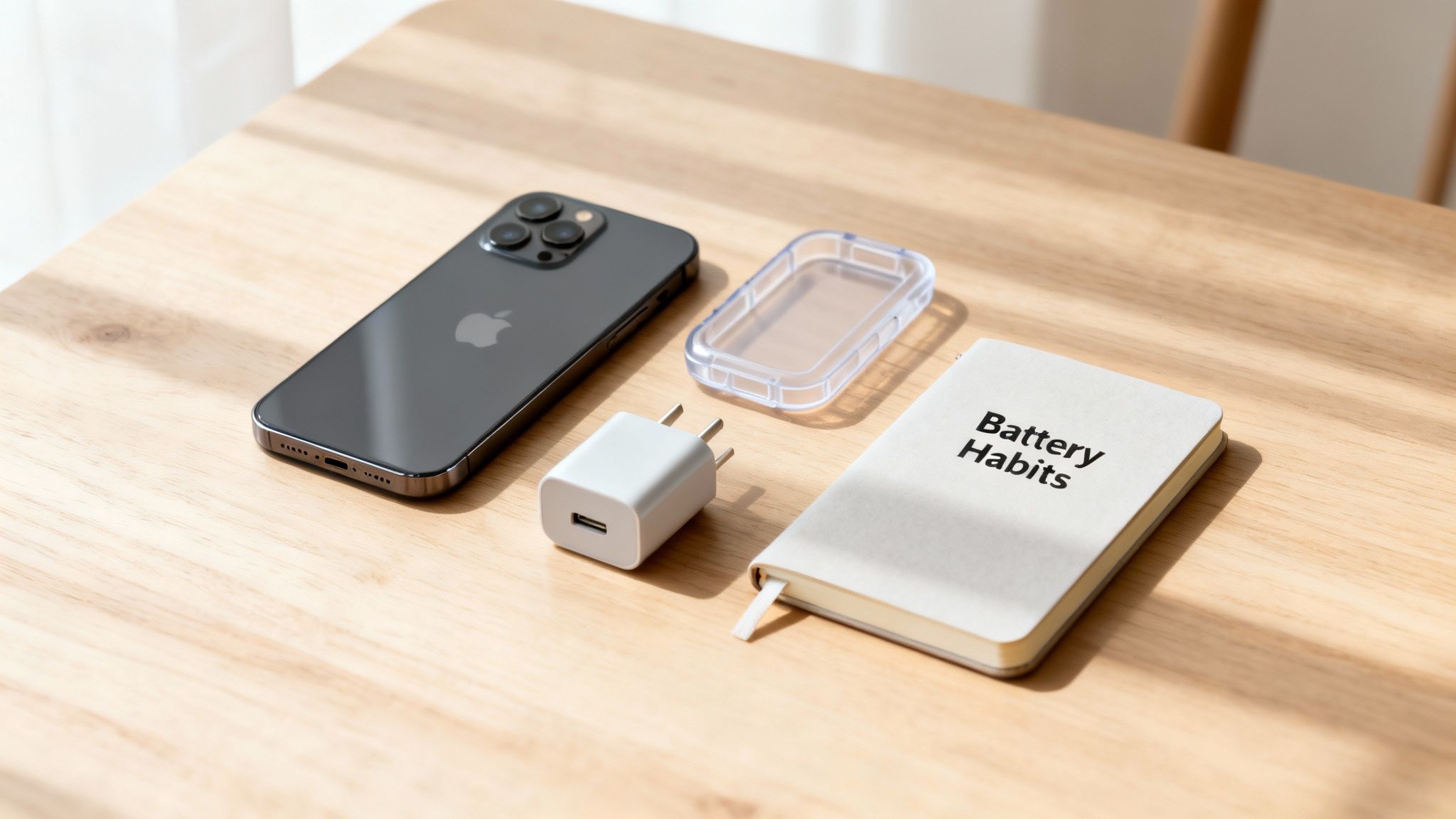
Embrace Your iPhone’s Built-in Protections
Apple knows battery health is a big deal, so they've built some smart features right into the software to help out. Your first and easiest step? Just turn them on.
Go to Settings > Battery > Battery Health & Charging. Think of this as your battery’s control center. The most important setting for most people is Optimized Battery Charging.
When you turn this on, your iPhone starts learning your daily charging routine. It will charge to 80% and then wait. It finishes off that last 20% right before you typically unplug it in the morning. This simple trick cuts down on the time your battery spends sitting at the stressful, high-power state of 100%.
If you have an iPhone 15 or newer, Apple gives you an even more powerful option: the 80% Limit. This setting does exactly what it sounds like—it stops the battery from charging past 80%. You lose a bit of daily runtime, but it’s the single best way to slow down the battery's aging process.
By using these built-in tools, you're letting the software do the heavy lifting. It’s a set-it-and-forget-it approach to better battery health that requires zero extra effort from you.
Avoid Extreme Hot and Cold Temperatures
Your iPhone’s battery has a comfort zone. It’s happiest between 32° and 95° F (0° and 35° C). Pushing it outside this range can cause permanent damage.
- Scorching Heat: Leaving your phone on a car dashboard in the summer or in direct sunlight at the beach is very bad for your battery. Heat speeds up the chemical reactions inside, causing it to wear out much faster.
- Frigid Cold: Cold weather isn't great, either. While the effects are often temporary, using your phone in freezing temperatures can reduce its ability to hold a charge until it warms up.
The takeaway here is simple: treat your iPhone like you'd treat a pet. Don't leave it in a hot car, and when it’s freezing outside, keep it in an inside pocket. This little bit of care goes a long way.
Master Your Charging Habits
Beyond the automatic software tricks, your own charging habits play a huge part. Let's bust the biggest myth right now: you do not need to drain your battery to 0%. That was true for old-style batteries, but for modern lithium-ion batteries, it’s actually harmful.
The sweet spot for a lithium-ion battery is keeping it between 20% and 80%. Think of it as giving it small, frequent snacks rather than a huge meal. Short top-ups are much healthier than deep, full charges from empty to full. This is where tools like Chargie can help by automating this process for you.
And please, use high-quality, MFi-certified (Made for iPhone) chargers and cables. Those cheap, uncertified gas station chargers can deliver unstable power, stressing and damaging your battery over time. It’s a classic case of "you get what you pay for." For a deeper dive into these ideas, you can learn more about what Optimized Battery Charging is and how it all works.
Hunt Down Battery-Draining Apps
Finally, not all apps are created equal. Some are known for using power in the background, even when you're not using them.
Head over to Settings > Battery. Scroll down, and you'll see a list of which apps have used the most power in the last 24 hours or the last 10 days.
If you spot an app you barely use sitting near the top of that list, that’s a huge red flag. It’s often an app that’s constantly using your location or getting data in the background. You can fix this by turning off its background activity (Settings > General > Background App Refresh) or, if you don't really need it, just delete it. Regularly removing these power-hungry apps ensures your battery life is being spent on things you actually care about.
A Few Lingering Questions About iPhone Battery Health
Even after going through the whole process, you might still have a few questions. That's totally normal. Figuring out battery issues can feel a bit like detective work, but the answers are usually pretty simple.
Let's clear up some of the most common questions that pop up when people try to get their iPhone battery reporting straight. The idea is to get rid of any confusion so you can feel confident managing your battery from here on out.
Why Does My iPhone Battery Percentage Still Drop So Fast?
If you’ve done a full recalibration and the battery is still draining very quickly, that’s a big clue. It tells you the problem isn't the software reporting the charge anymore—it's the physical battery itself. Think of it this way: you fixed the "fuel gauge," but you can't magically add more fuel to a smaller tank.
A battery with a Maximum Capacity below 80% is getting old. It has physically worn down, meaning it just can't hold the same amount of energy it could when it was new. No amount of software tweaking can change that physical reality. It's the clearest sign you'll get that it’s time to look into a professional battery replacement.
Can I Damage My iPhone by Draining the Battery to 0%?
This is a great question. While making a habit of running your battery completely flat is a bad idea for its long-term health, doing it just once for a specific recalibration is perfectly safe.
Here's how to think about it:
- As a Daily Habit: Constantly draining your battery to zero is like running a marathon every single day. It puts a ton of stress on the battery and makes it wear out faster.
- As a One-Time Fix: Draining it once as part of a controlled process is more like a necessary stress test. It's a specific action to fix a specific problem, and it won't cause any lasting harm.
Your iPhone is smart enough to protect itself. It has built-in safety features to stop the battery from draining to a level that would cause real damage. When it finally shuts down at "0%," there's still a tiny, safe reserve of power left.
How Often Should I Recalibrate My iPhone Battery?
Honestly, you shouldn't have to do this very often. If your battery percentage seems to be working correctly, just leave it alone. There's no benefit to recalibrating a battery that's already working properly.
A good rule of thumb is to only perform a recalibration when you see clear signs that something's off—like the phone suddenly dying at 30% or the percentage jumping around.
For most people, this might be something you do once a year at most. You might consider it after a major software update if you notice strange battery behavior. Over-calibrating is just unnecessary work that puts extra wear on your battery for no good reason.
Will a Factory Reset Improve My Battery Health?
No, a factory reset won't do anything to improve your battery's physical health. That Maximum Capacity percentage you see in Settings is a hardware measurement. It’s a direct reflection of the battery's age and physical condition. Wiping the software and starting from scratch can't reverse that.
What a factory reset can do, however, is fix severe battery drain caused by a deep software problem or a misbehaving app that other troubleshooting couldn't fix. It's the "nuclear option" for software problems, not a magical battery-rejuvenation tool. If you go through a full reset and your battery life is still terrible, you can be almost certain the hardware is the problem.
Of course, protecting your battery from day one is the best way to avoid these issues entirely. Chargie is designed for exactly that, automatically managing your charging to keep your battery in that sweet spot between 20-80%. By preventing the stress of overnight charging to 100%, it can extend your battery's lifespan by up to 4x, saving you from pricey replacements and cutting down on e-waste. Learn how Chargie can safeguard your device's battery health.


